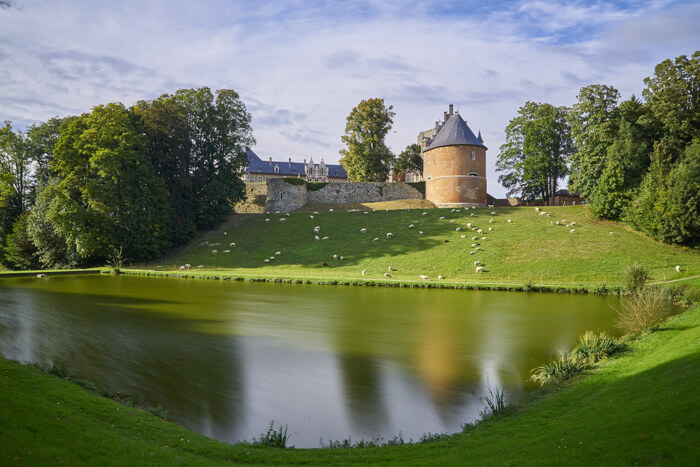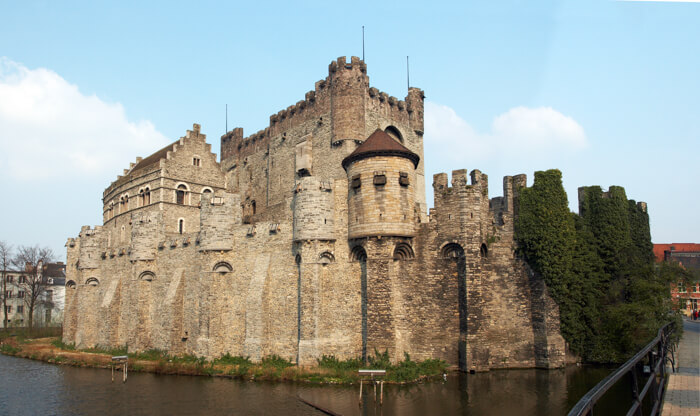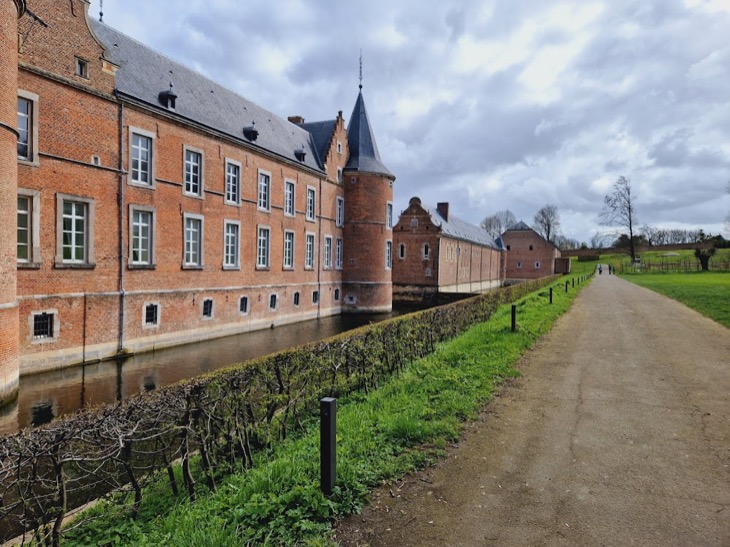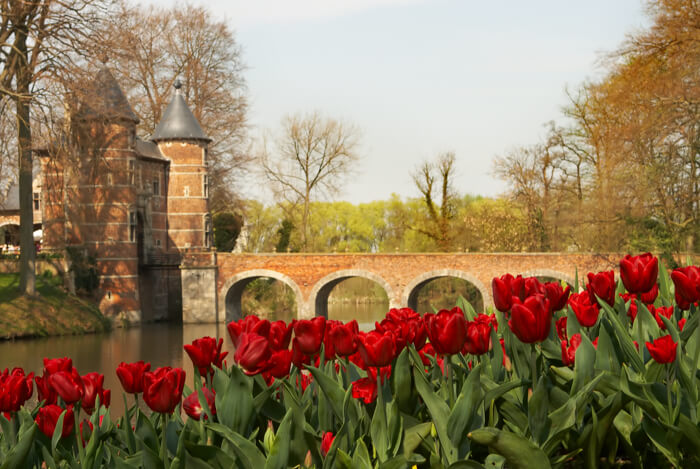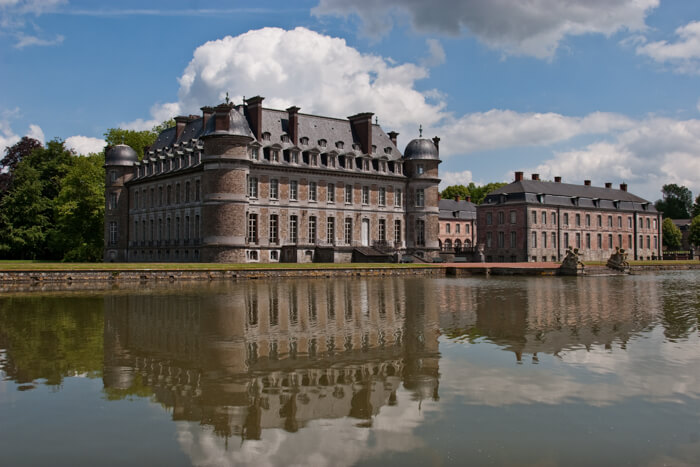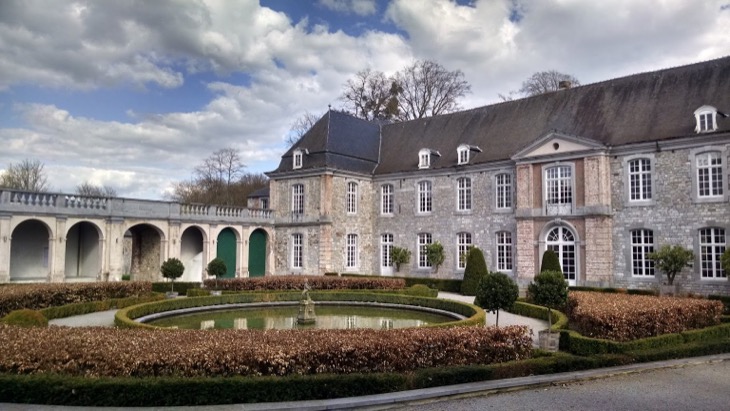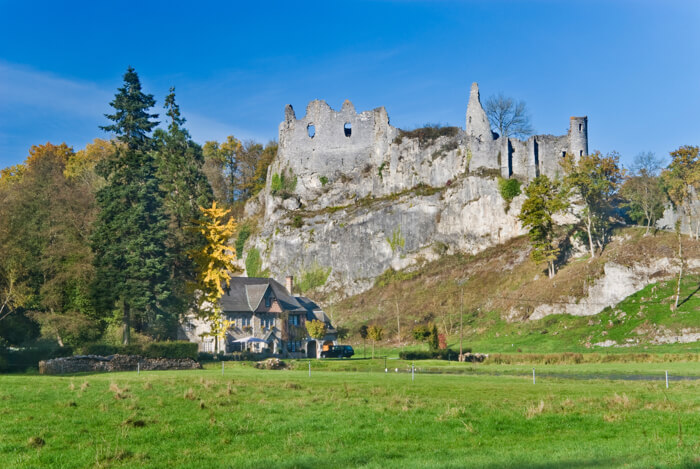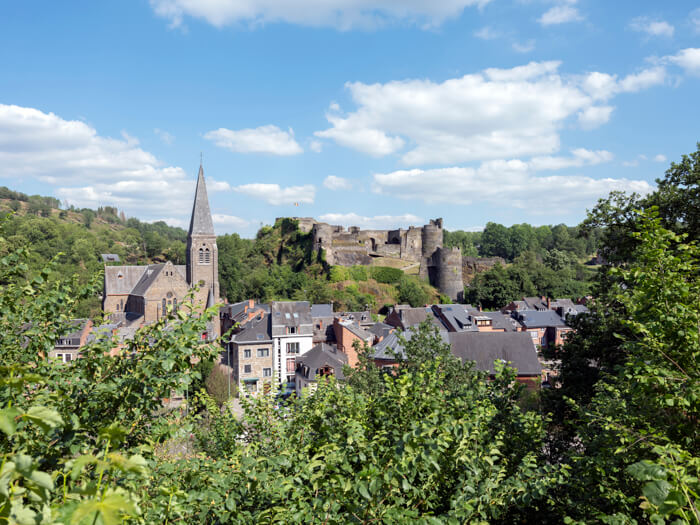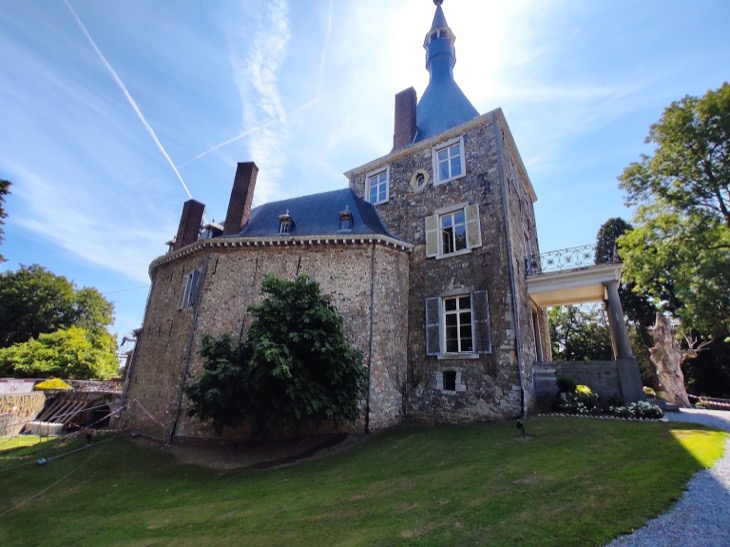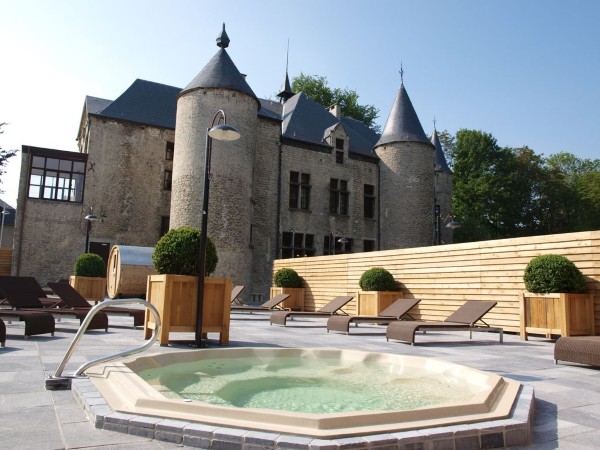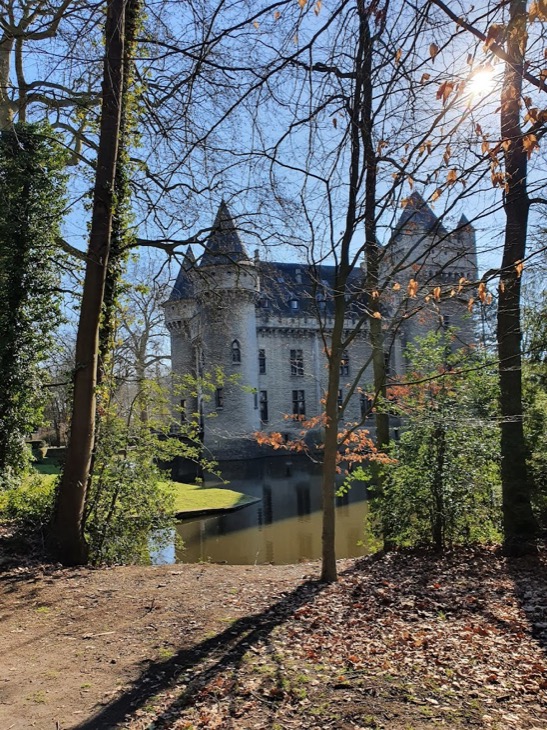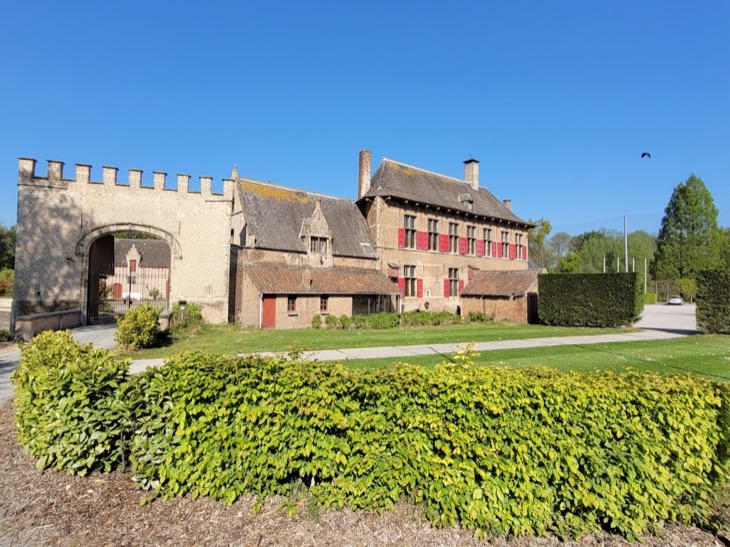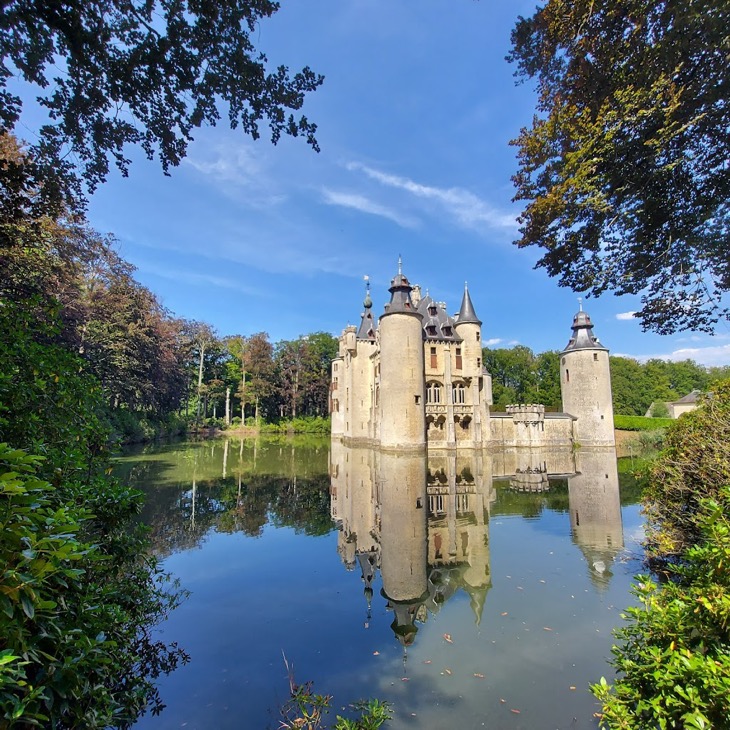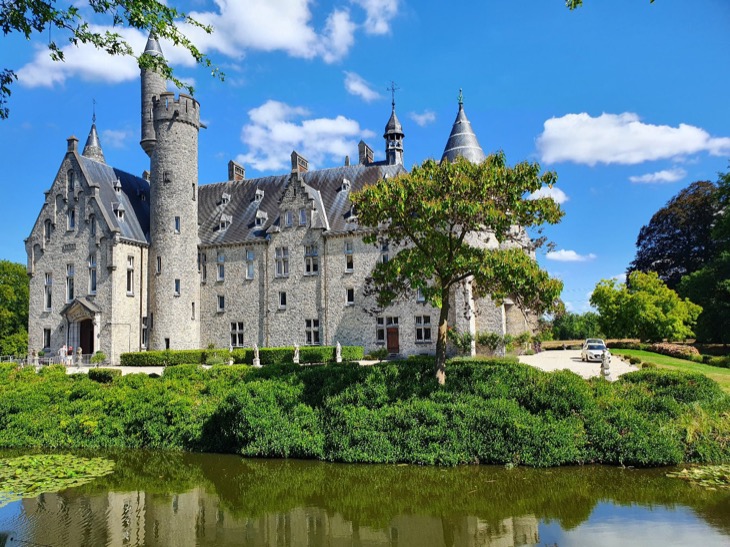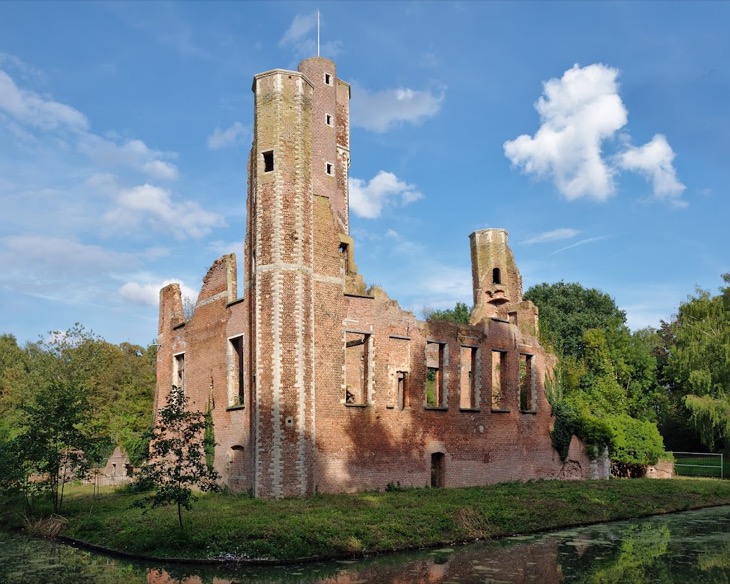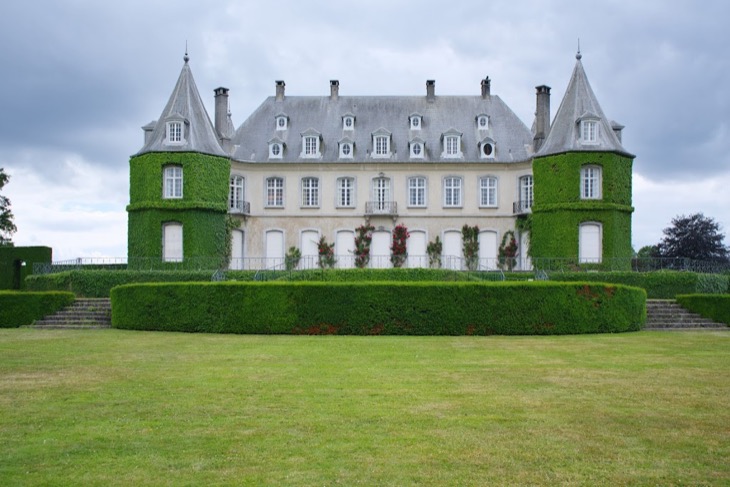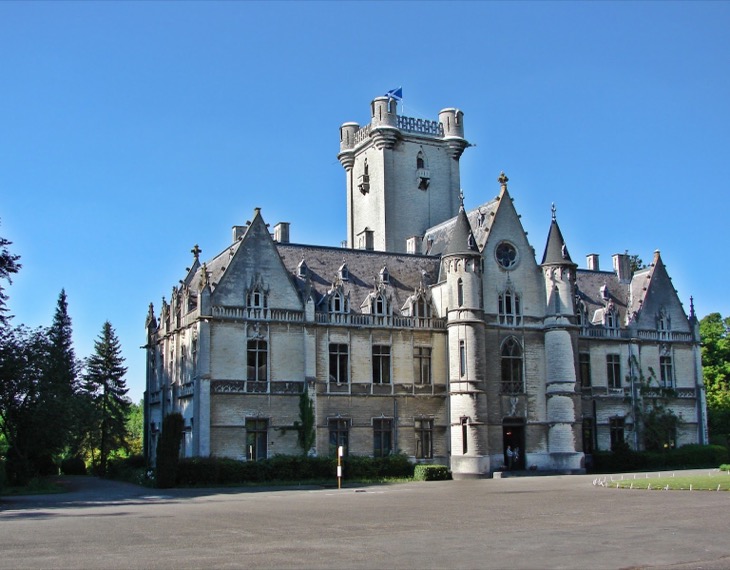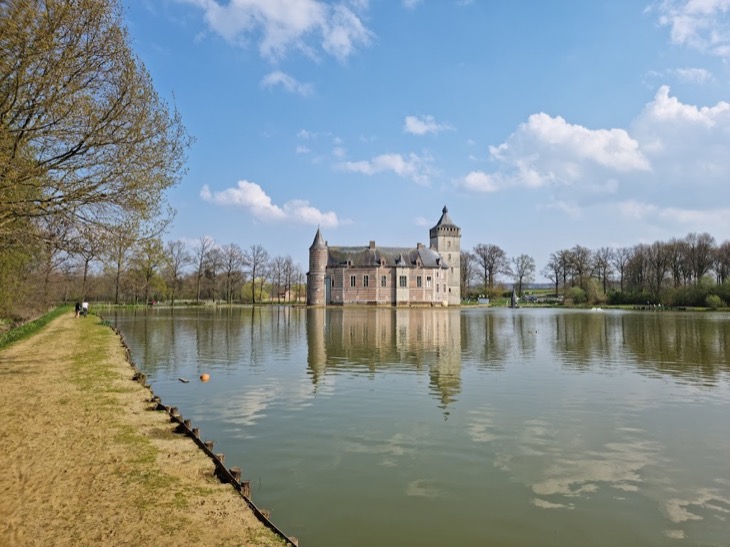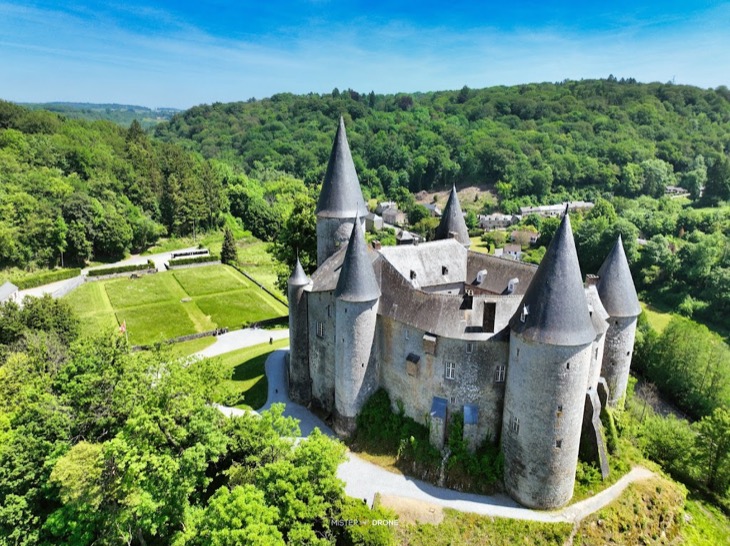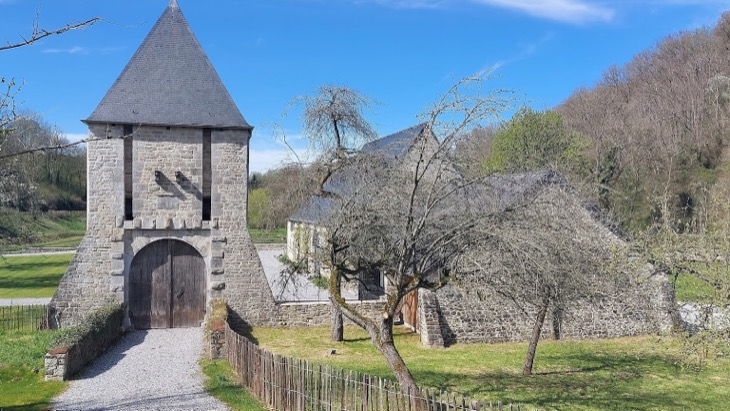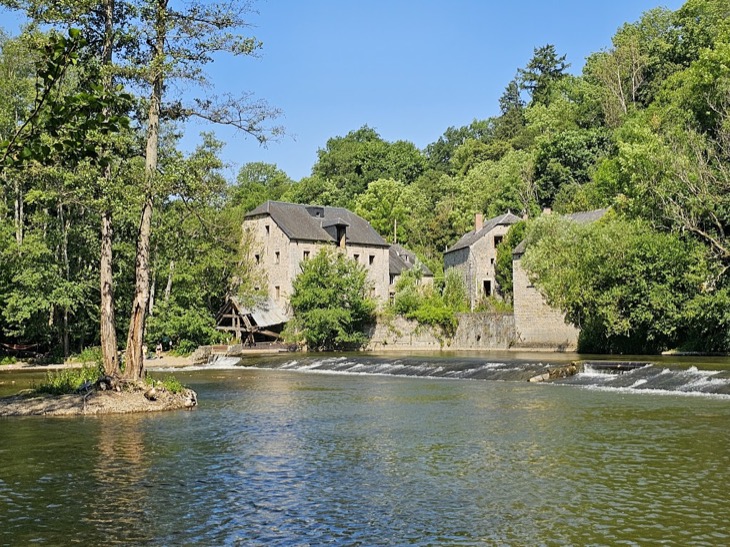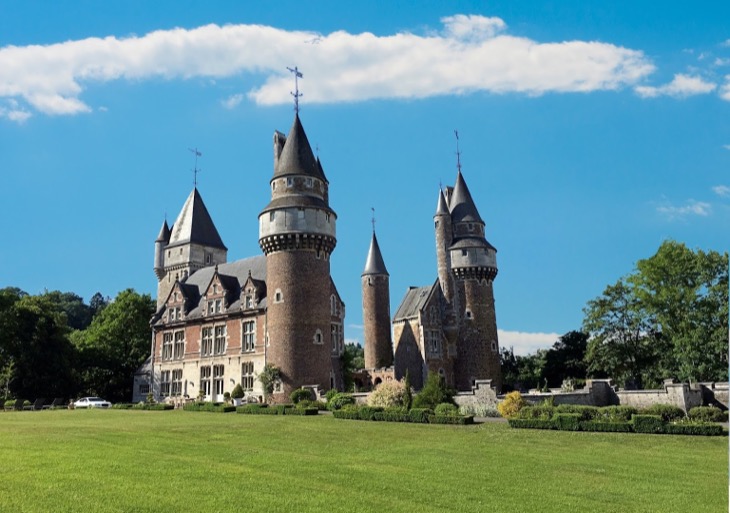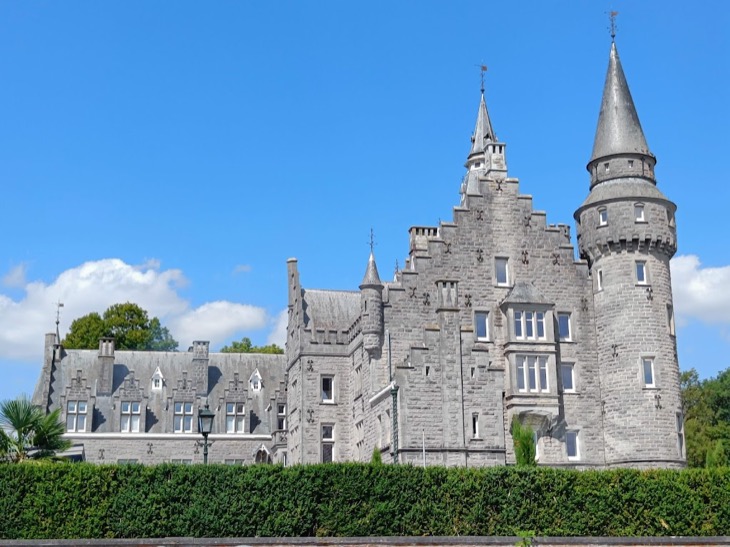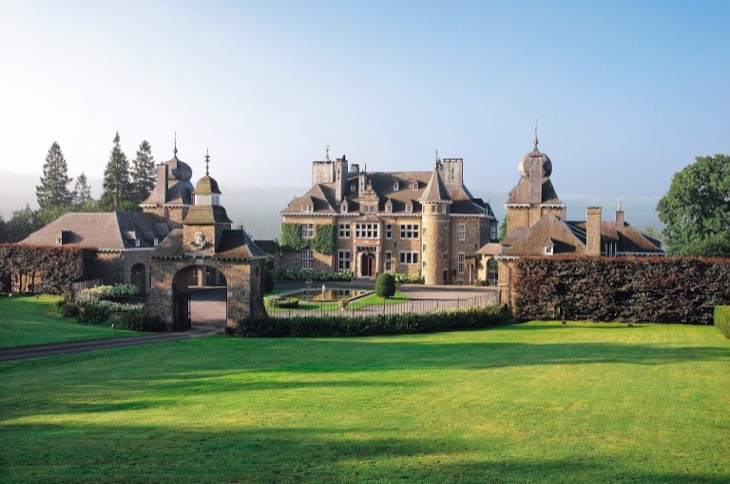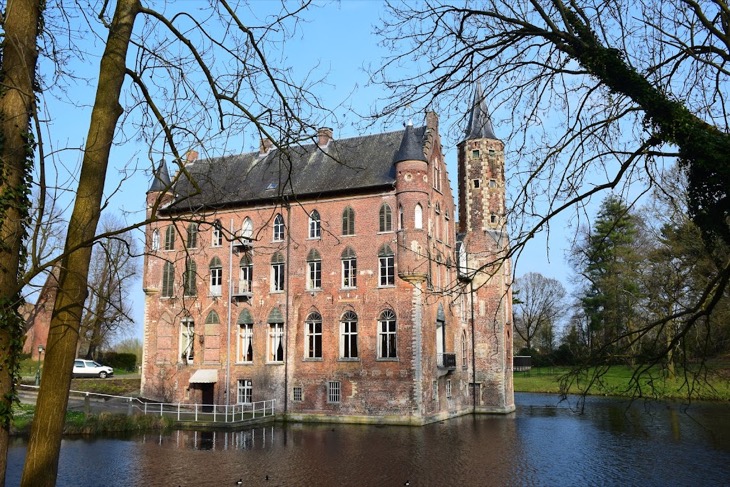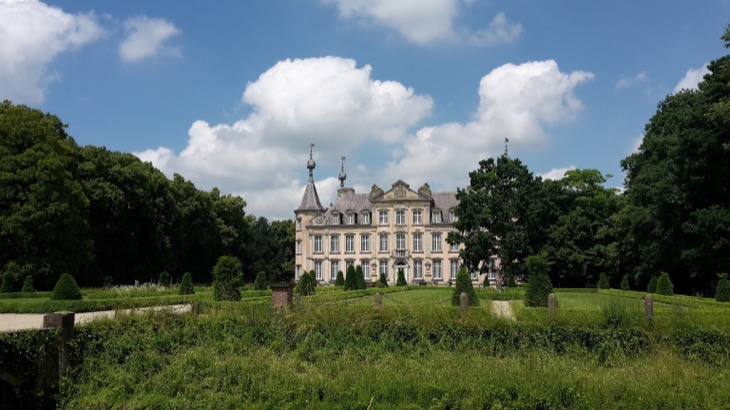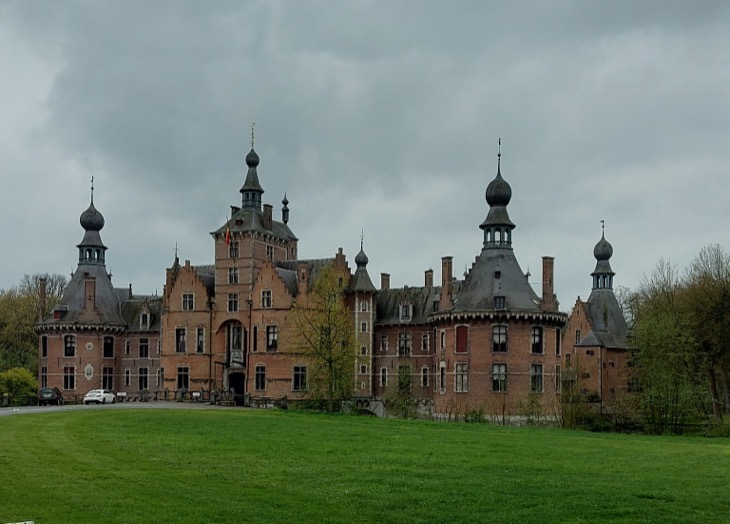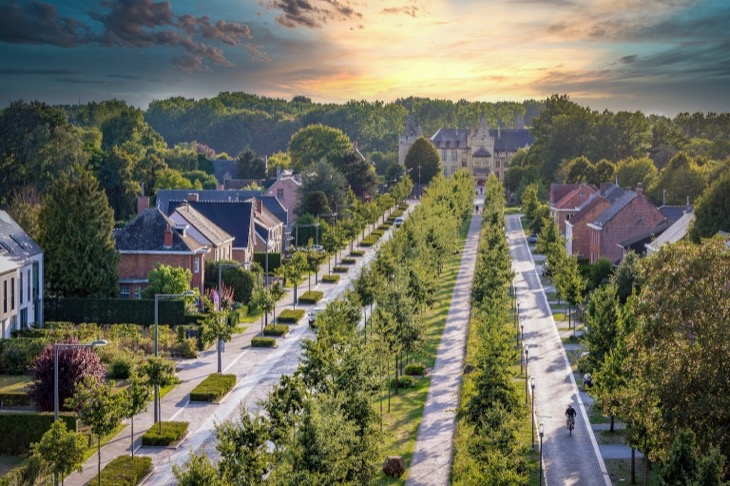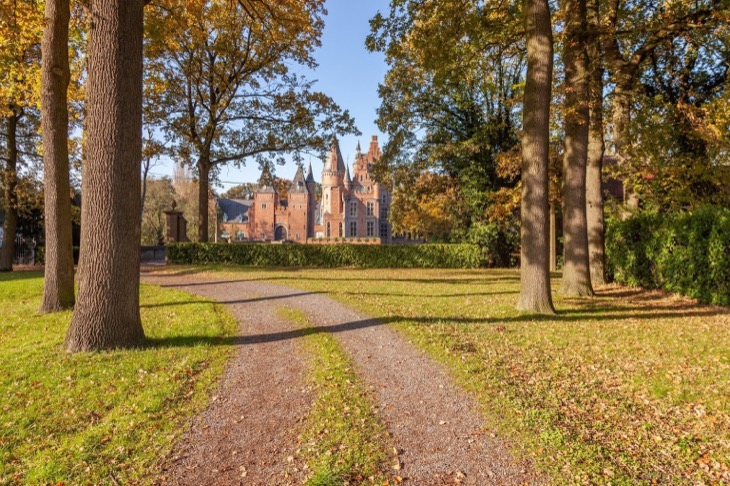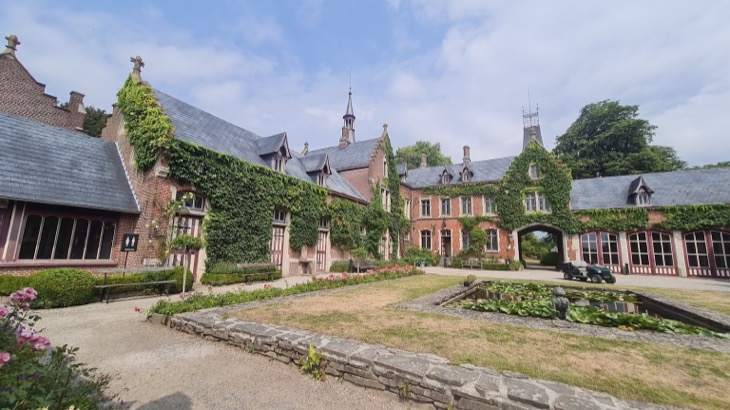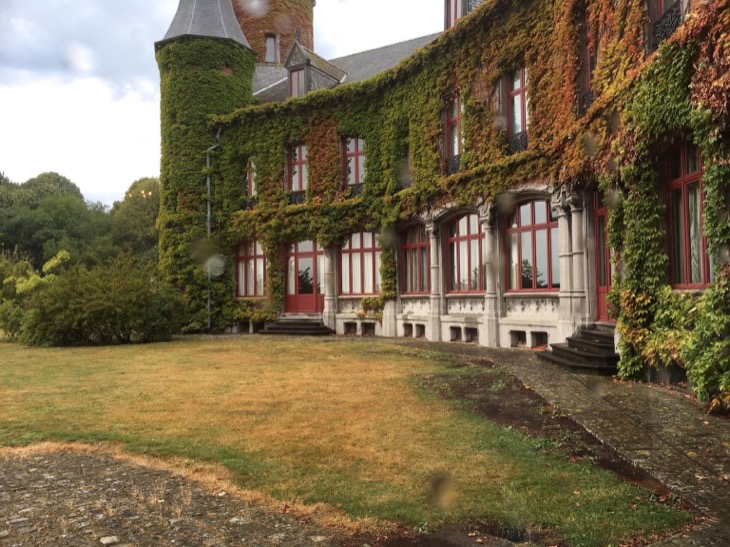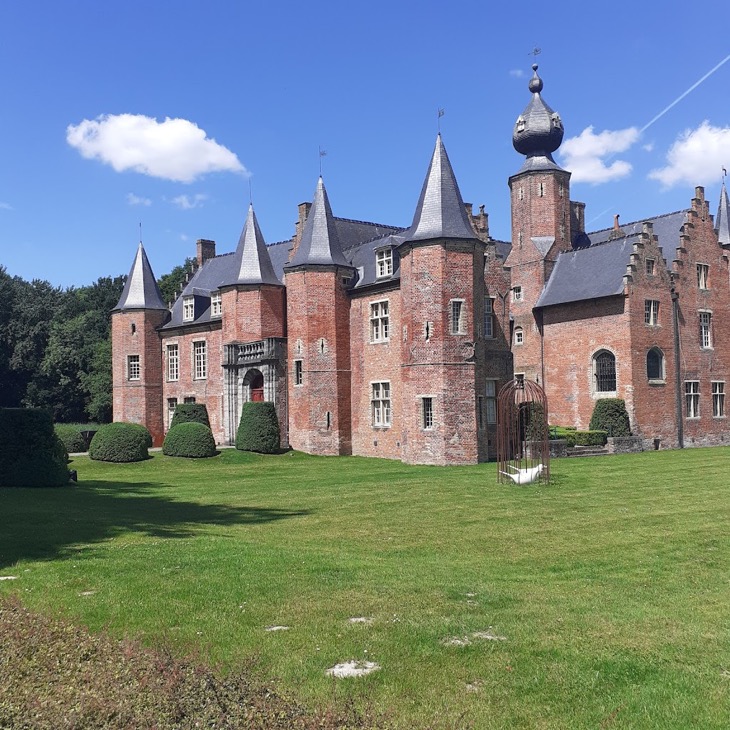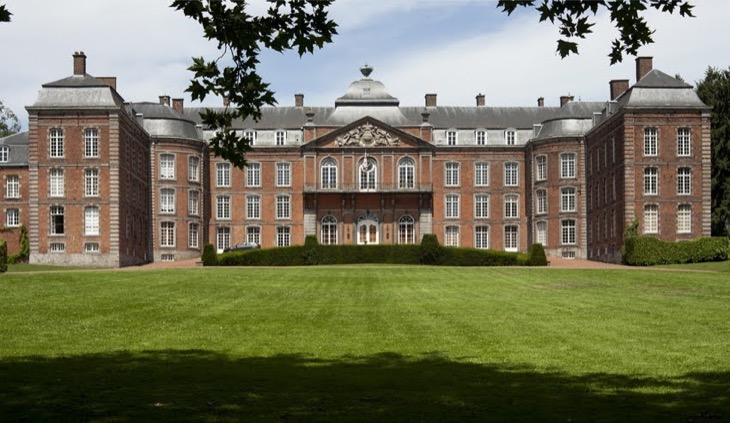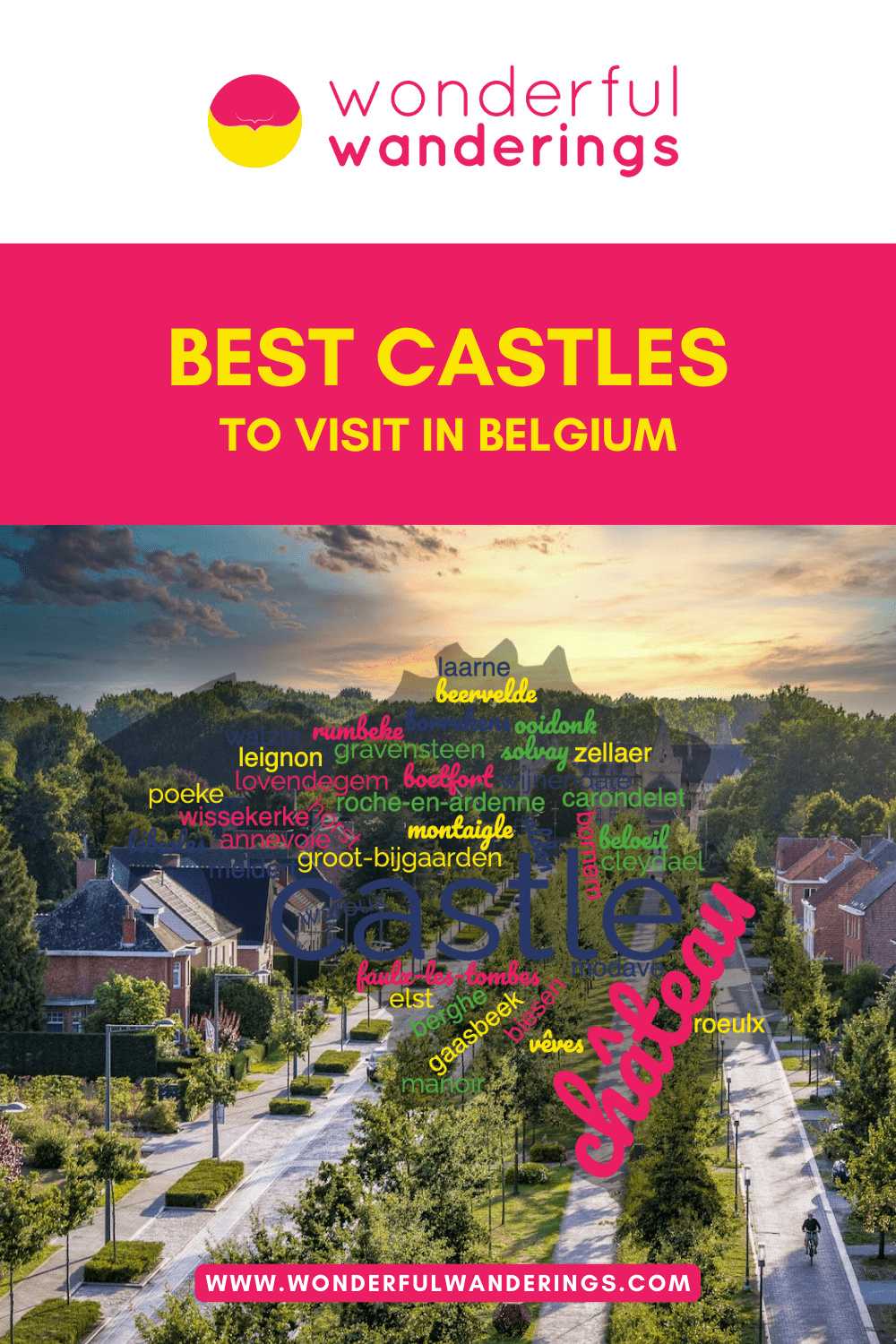Did you know that there are over 3000 castles in Belgium? That makes more castles per capita than France which is famous for its chateaux. Many of these structures were built long before Belgium even became a country, while some are more recent. What they all have in common is a varied and fascinating history.
When you hear the word “castle” you might think of a typical medieval military affair, with castellated towers and defensive portcullises. However, there is a wide and far-ranging spectrum of castles in Belgium. Some are rugged fortifications with arrow slits and drawbridges, while other castles are refined stately homes.
Many of these castles are still occupied by the old aristocracy, nobility and members of former royal families with decadent paintings of ancestors flanking their halls. You can still visit parts of many of these Belgium castles.
Listed below are the best Belgium castles.
- Castle of Gaasbeek. The Castle of Gaasbeek is a medieval castle located near Brussels, Belgium. It has been restored in a romantic neo-Gothic style and contains rich decor and artifacts.
- Gravensteen. Gravensteen is a well-preserved medieval castle in Ghent, Belgium that served as the residence of the Counts of Flanders. It is now a museum displaying medieval arms, torture devices and panoramic views from the ramparts
- Alden Biesen Castle. Alden Biesen Castle is a 16th century moated castle in Limburg, Belgium that has been carefully restored and is now used as a cultural center. Visitors can see the grounds, museum and attend events at the castle.
- Groot-Bijgaarden Castle. Groot-Bijgaarden Castle is a 12th century moated castle near Brussels having architecture blending medieval and Renaissance styles. Its gardens host the popular Floralia flower exhibition each spring.
- Château de Beloeil. Château de Beloeil is an 800 year old castle in Hainaut, Belgium that was transformed into a Baroque palace and contains lavish interiors and 25 hectare French gardens.
- Château de Modave. Château de Modave is a beautifully preserved 17th century Baroque castle overlooking the Hoyoux River valley in Modave, Belgium. Tours are available to see its historic interiors.
- Annevoie Castle. Annevoie Castle in Namur, Belgium dates back to the 17th century and is surrounded by renowned gardens with gravity-powered fountains, cascades and ponds.
Contents
- 1. Castle of Gaasbeek
- 2. Gravensteen
- 3. Alden Biesen Castle
- 4. Groot-Bijgaarden Castle
- 5. Château de Beloeil
- 6. Château de Modave
- 7. Annevoie Castle
- 8. Montaigle Castle
- 9. La Roche-en-Ardenne Castle
- 10. Château De Waroux
- 11. Boetfort Castle
- 12. Castle of Zellaer
- 13. Cleydael Castle
- 14. Borrekens Castle
- 15. Bornem Castle
- 16. Castle Ter Elst
- 17. Solvay Castle
- 18. Castle of Meldert
- 19. Horst Castle
- 20. Castle of Vêves
- 21. Carondelet Castle
- 22. Walzin Castle
- 23. Faulx-les-Tombes Castle
- 24. Leignon Castle
- 25. Manoir de Lébioles
- 26. Wissekerke Castle
- 27. Poeke Castle
- 28. Ooidonk Castle
- 29. Laarne Castle
- 30. Lovendegem Castle
- 31. Castle of Beervelde
- 32. Castle Ten Berghe
- 33. Wijnendale Castle
- 34. Rumbeke Castle
- 35. Château de Le Roeulx
1. Castle of Gaasbeek
Castle of Gaasbeek, locally known as Kasteel van Gaasbeek, is a medieval castle located in the village of Gaasbeek, within the municipality of Lennik in Flemish Brabant province of Belgium. The fortified castle was constructed around 1240 CE to defend the Duchy of Brabant against invaders from the County of Flanders. Throughout its 800-year history, Castle of Gaasbeek has been destroyed and rebuilt several times. The current structure largely dates back to the late 19th century, when the castle was renovated and redesigned in a romantic neo-Gothic style.
Castle of Gaasbeek is situated about 10 km southwest of Brussels, with the capital city being the nearest major urban area. The castle has an irregular polygonal layout and is surrounded by moats filled with water. It contains three courtyards, a Gothic chapel dedicated to St. Gertrude and an expansive 50-hectare park featuring winding paths, ponds and gardens. The interiors are lavishly decorated in a neo-Renaissance style and adorned with Flemish tapestries, antique furniture, paintings, silverware and other precious artifacts. Visitors can see the preserved bedroom, bathroom and lounge used by its last inhabitant, the Marquise Arconati Visconti.
The castle structure encompasses imposing crenelated towers, high walls, dungeons and ramparts. The towers and exterior fortifications hint at its medieval military past, while the romantic interior design reflects a 19th century aesthetic.
Castle of Gaasbeek is open to public visitation from Tuesday to Sunday. The castle, park and gardens can be explored through guided tours. There is also a museum on the premises displaying the castle’s extensive art, artifacts and furniture collection.
Visitors can reach the castle easily by car, bus or train. Bus 142 from Brussels South Station goes directly to the castle grounds. Trains run frequently between Brussels and Lennik village, which is just 2 km away.
Given its proximity to Brussels, ornate architecture, scenic grounds and rich history, Castle of Gaasbeek is a worthwhile attraction to visit for those interested in Belgian medieval history. The beautiful countryside setting also makes it a great option for a day trip from Brussels. Walking the shaded alleys of the expansive park grounds offers an immersive experience and transports visitors back in time.
2. Gravensteen
Gravensteen translates as “Castle of the Counts”, is a medieval castle located in the heart of Ghent, Belgium. The castle was originally built in the 9th century by Count Baldwin I to defend against Viking raids. In the 11th century, it was rebuilt in stone by Count Robert I. The current castle largely dates from 1180, when Count Philip of Alsace constructed a new stone keep and fortifications, likely inspired by crusader castles he had seen.
Gravensteen served as the residence of the Counts of Flanders until the 14th century. After the counts moved out, it was used as a courthouse, prison and mint. In the 19th century, parts of Gravensteen were sold off and converted into a cotton mill with worker housing. By the late 1800s, the site was dilapidated and threatened with demolition before being saved by preservationists.
Restoration of the castle began in the 1890s and aimed to recreate its 12th century appearance during Philip of Alsace’s rule. Gravensteen was a major attraction at the 1913 World Fair in Ghent. Today, the well-preserved castle is a museum open to the public. Visitors can see the gatehouse, battlements, keep, residence and stables. The castle has two small museums – one displaying medieval arms and armor, the other showcasing gruesome judicial torture devices from when Gravensteen served as a prison. Tourists can walk along the ramparts for panoramic views of Ghent.
At an imposing 97 feet tall, the central stone keep has four floors and is ringed by a fortified stone wall lined with 24 small turrets. Gravensteen Castle is surrounded on three sides by a moat fed by the River Leie. The castle grounds also contain the renovated Saint Pharaildis Church.
Gravensteen provides a window into medieval life. Its imposing architecture and bloody history make it one of Belgium’s most popular castles to visit. Easily accessible by train or car, Gravensteen is a must-see for any tourist visiting Ghent.
3. Alden Biesen Castle
Alden Biesen Castle is a 16th-century castle located in the small village of Rijkhoven in the municipality of Bilzen, in the province of Limburg, Belgium. The castle was constructed between the 16th and 18th centuries on the site of an 11th century Teutonic Order commandery. It is placed in the Late Middle Ages and Early Modern Period. Today, Alden Biesen Castle is mostly preserved and restored, after suffering damage over the centuries. The castle has been carefully restored to its former glory, with renovations in the 1970s after a devastating fire and is now used as a cultural center.
The structures of Alden Biesen Castle include the moated castle itself, as well as a church, gardens and several other buildings. The castle complex contains towers, a moat, drawbridges and ramparts. There is a small museum in the castle that explains its history.
The nearest city to Alden Biesen Castle is Bilzen, which is about 2 miles away. Tourists can visit the castle grounds and certain areas, like the museum, for free. The castle hosts events, concerts and festivals throughout the year that visitors can attend.
To get to Alden Biesen Castle, the nearest train station is in Bilzen, then it is a short 10 minute walk or taxi ride to the castle. There is parking available right at the castle grounds for those arriving by car.
Visiting Alden Biesen Castle is worthwhile for history and architecture enthusiasts. The well-preserved castle provides a glimpse into medieval life with its imposing moats and drawbridges. Tourists can appreciate the care taken to restore the buildings and gardens to their former glory. The castle grounds are ideal for a picnic or a peaceful stroll. With regular events held in the unique setting, Alden Biesen Castle is both an educational experience and a cultural destination.
4. Groot-Bijgaarden Castle
Groot-Bijgaarden Castle is a 12th century castle located in Groot-Bijgaarden, in the municipality of Dilbeek, Flemish Brabant, Belgium. The castle was originally built for Almaric Bigard, the first lord of Bigard in the 12th century. It is situated at an elevation of 47 meters.
The castle is surrounded by a wide moat that is spanned by a five-arch bridge leading to the drawbridge. The central part of the gatehouse dates back to the 14th century. A 30 meter high four-story tower, known as the dungeon, stands next to the gatehouse and was built around 1347.
Most of Groot-Bijgaarden Castle was constructed in the 14th and 17th centuries in a blend of medieval and Flemish Renaissance architectural styles. The castle is made of red brick with a slate roof. In 1902, the castle was in a dilapidated state when it was acquired by Raymond Pelgrims Bigard, who spent 30 years restoring it.
The castle is accompanied by 14 hectares of landscaped gardens that were designed by Louis Fuchs in the early 20th century. Every spring since 2003, the gardens host Floralia, an international flower exhibition featuring over 400 tulip varieties from the Netherlands.
The castle’s prominent structures include the gatehouse, dungeon tower, drawbridge, moat and five-arch bridge. The tower stands 30 meters tall with 2 meter thick walls. Visitors can climb to the top of the tower for panoramic views of the countryside.
There is a small museum located inside the chapel wing of the castle. Guided tours are offered to provide information about the history and architecture of the castle.
The nearest city to Groot-Bijgaarden Castle is Brussels, located just 7 km away. It can easily be reached by train from Brussels in about 20 minutes.
Tourists are unable to visit the interior of the castle since it is privately owned. However, the gardens are open to the public for one month each spring during the Floralia flower exhibition. Tickets can be purchased on the website.
Visiting the castle grounds during Floralia provides a beautiful setting to admire the architecture and stroll through acres of vibrant spring flowers. The event is smaller than the famous Keukenhof gardens but also less crowded. For flower lovers near Brussels, it is certainly worth a visit to Groot-Bijgaarden Castle during the limited time it is open each year.
5. Château de Beloeil
Château de Beloeil is a castle located in the municipality of Beloeil in the province of Hainaut, Belgium. The castle dates back to the 13th century when it was built as a medieval fortress, with four corner towers and a moat surrounding it. Over the centuries, it was transformed into a luxurious French-style palace and country home for the Princes de Ligne family, who have owned it since 1394.
The current Baroque structure of Château de Beloeil was constructed in the 17th and 18th centuries. Major rebuilding occurred after a fire devastated the castle in 1900. Today, the castle is approximately 800 years old. It is well-preserved and maintains much of its original medieval layout, including towers, a moat, drawbridges and ramparts.
Inside, Château de Beloeil contains 12 ornately furnished rooms exhibiting artwork and artifacts ranging from the 15th to 19th centuries. The most notable interior feature is the Library with over 20,000 books and a beautiful wooden interior. Outside, the grounds span 25 hectares and feature geometric French gardens originally designed in 1664. The gardens contain statues, ponds, allees and scenic views of the countryside.
The castle serves as a museum open for public tours, particularly during spring and summer. The nearest major city is Mons, about 30 kilometers away. Tourists can drive or take the train to the Beloeil station then walk or take a bus to reach the castle.
Visiting Château de Beloeil is highly recommended for history and architecture buffs. The medieval fortress architecture combined with the lavish Baroque interior makes this an exceptionally unique castle in Belgium. Tourists can admire stunning artwork and decor while learning about the Princes de Ligne family’s rich history. Strolling through the sprawling French gardens is also a highlight. Château de Beloeil offers a glimpse into Belgium’s past in an idyllic countryside setting.
6. Château de Modave
Château de Modave is a castle located in Modave, Belgium. It sits on a rocky outcrop 60 meters above the Hoyoux River valley, offering magnificent views of the surrounding 450-hectare nature reserve. Château de Modave has origins dating back to the 13th century when the first fortress was built on the strategic site by the Lords of Modave. The present castle was constructed in the late 17th century when Count Jean-Gaspard-Ferdinand of Marchin acquired the property and transformed the medieval fortress into an elegant Baroque residence. Château de Modave is an exemplary model of 17th-century High Baroque country house architecture.
The castle contains beautiful interior stucco work, tapestries, paintings and antique furniture dating back to the 17th and 18th centuries. It has towers, ramparts, moats and dungeons that visitors can see. There is no museum inside Château de Modave itself, but tours of the historic rooms and audio guides are available when the castle is open to the public from April to November.
The nearest city to Château de Modave is Huy, about 13 km away. Tourists can visit the castle and walk around its grounds. Tickets can be purchased online or at the entrance. The castle can be reached by car via the E42 motorway, exiting at Huy and following signs to Modave village. There is free parking available on site.
Given its history, architecture and beautiful setting, visiting Château de Modave is worthwhile for travelers interested in Belgian castles and heritage sites. The interiors are remarkably well preserved with elaborate ceilings and tapestries. Visitors can admire the architecture and surroundings while learning about the various noble families who lived there over its 700 year history. The castle’s hilltop location also makes it a scenic spot to take in views of the Hoyoux River valley.
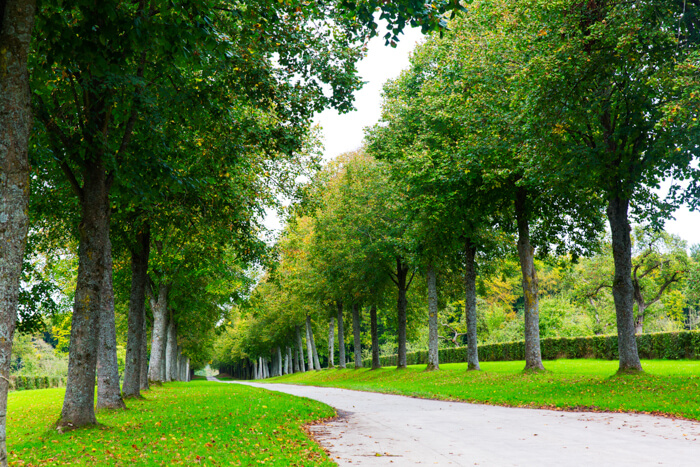
7. Annevoie Castle
Annevoie Castle is located in the village of Annevoie-Rouillon in the municipality of Anhée, in the province of Namur, Belgium. The castle was constructed in the 17th century and originally belonged to the Halloy family before being inherited by the Montpellier family in 1696.
The current structure of Annevoie Castle dates back to expansions made in the 18th century under Charles-Alexis de Montpellier. He added new wings to the original 17th century manor house and remodeled the castle in a classical style. The facade facing the gardens clearly shows the different construction eras since 1627.
Annevoie Castle is from the Baroque period. It has been preserved and maintained by the Montpellier family for over 300 years. The castle features a curved facade reflecting the shape of the valley, with two main levels and a brick edged frieze. The interior has rich decorations and furnishings.
The castle is surrounded by the renowned 18th century water gardens, known as the Jardins d’Annevoie. The gardens contain English, French and Italian elements, with over 50 fountains, cascades, ponds and waterfalls powered entirely by gravity and the area’s natural springs, without the use of any pumps.
The gardens feature a 400-meter long canal, statues, flower beds, an orchard and a menagerie. The grounds are open to the public, but Annevoie Castle itself is not open for tours. Visitors can view the exterior of the elegant castle from within the gardens.
Annevoie Castle is located just 20 minutes from the city of Namur. It can be easily reached by car or public transportation like buses and trains. The gardens are open daily from April to November, making it an ideal tourist attraction.
Given its history, architecture and famous gardens, Annevoie Castle is definitely worth visiting for any traveler interested in Belgian castles or beautiful landscaped gardens. The unique water features powered entirely by nature provide an extra element of fascination.
8. Montaigle Castle
Montaigle Castle is a ruined medieval fortress located in the village of Falaën in the municipality of Onhaye, in the province of Namur, Wallonia region of Belgium. The castle was constructed in the 14th century and is from the Middle Ages. It was built on an earlier Roman fortification that existed at the site between 260-450 AD. Montaigle Castle sits on a rocky spur overlooking two valleys – the Molignée Valley and the Flavion Valley.
The castle was founded around 900 AD and was initially known as Faing Castle until the 14th century. In the early 12th century, it went to the Count of Namur and was later sold to Guy of Flanders in 1298 who rebuilt it. However, Montaigle Castle was destroyed in 1554 by King Henry II of France and left in ruins. Since then, it has been uninhabited. Over the centuries, parts of the ruins were inhabited again and locals also used it as a stone quarry. Efforts to preserve Montaigle Castle began in 1865 and restoration works have been undertaken since then.
Today, the ruins of Montaigle Castle consist of partial exterior walls, outlines of some interior rooms, the courtyard, a well and some cellars. The ruins showcase remnants of a 14th century fortress. There are no intact towers, moats, drawbridges, dungeons or ramparts remaining that can be visited. However, the site offers scenic valley views. Adjacent to the ruins is an archaeological museum that provides insights into medieval life through artifacts found at the site. The 100 sq m museum exhibits items like cannonballs, tools, pottery, coins, jewelry etc.
The nearest city is Namur located around 23 km away. Montaigle Castle is open for public visitation and tourists can explore the ruins and museum from April to November. The site can be accessed by car and has limited parking. The castle is located in a rural area but is worth a visit for those interested in medieval architecture and history. As an Exceptional Heritage Site of Wallonia, Montaigle Castle ruins offer a glimpse into the region’s past in a picturesque natural setting.
9. La Roche-en-Ardenne Castle
La Roche-en-Ardenne Castle is a ruined medieval castle located in the town of La Roche-en-Ardenne in the province of Luxembourg, Belgium. The castle’s origins date back to the 9th century CE when the first stone fortifications were built on the site of an ancient Celtic settlement. Over the next five centuries, the castle was expanded and strengthened with the addition of walls, towers and other defensive structures. The castle reached its peak in the 14th century under the Counts of La Marck.
The castle is situated on a rocky outcrop overlooking a bend in the River Ourthe in the hilly Ardennes region of Belgium. The nearest large city is Liege, located about 75 km to the northwest.
Though now in ruins, La Roche-en-Ardenne Castle remains an impressive example of medieval military architecture. The castle’s high stone walls and towers still stand, giving visitors a sense of the original scale and grandeur of the structure. Visitors can climb up to the top of the tower for panoramic views of the town and surrounding valley. The castle grounds also feature the remains of interior rooms and underground cellars carved into the bedrock.
While much of the castle has been lost over the centuries, the ruins have been partially restored and preserved. Guided tours are available and information panels provide details on the history and architecture of the castle. The site comes alive during the summer months with medieval-themed events like falconry shows, archery demonstrations and crafts fairs.
La Roche-en-Ardenne Castle is certainly worth visiting for any history or architecture enthusiast traveling through Belgium’s Ardennes region. The evocative ruins let visitors vividly imagine what life was like in a medieval stronghold, while the sweeping valley vistas showcase the castle’s strategic defensive location. Despite its dilapidated state, the castle remains an iconic landmark and popular tourist attraction.
10. Château De Waroux
Château de Waroux is a castle located in the village of Alleur, in the municipality of Ans in the province of Liège, Belgium. The castle was built around 1300 during the conflict between the Awans and Waroux families. It was originally built as a medieval fortress with high stone walls, square towers and a moat. Over the centuries, it was transformed into a stately home by its various noble owners including the Mérode and Clercx families.
The castle has a rare circular layout which makes it unique among Belgian castles. The walls are made of flint and limestone on the outside and brick on the inside. It contains a square keep and a gate tower. The interior courtyard is polygon-shaped, combining brick and cut stone architectural styles.
In 2005, Château de Waroux was purchased by the municipality of Ans. It is now used as a cultural center, hosting art exhibitions, concerts and other events throughout the year. The castle and its grounds are recognized as an Exceptional Heritage Site of Wallonia. Visitors can tour the castle during special events and exhibitions.
The nearest major city is Liège, located about 9 km away from the castle. The village of Alleur where Waroux Castle is situated can be reached by bus or train via the Ans railway station. Tourists visiting Liège often make a day trip to see the castle.
The castle grounds contain scenic gardens and lime trees surrounding the moat. Inside, visitors can view the medieval architecture including the remains of the old square keep. The polygon courtyard and historical artifacts on display provide a window into the interesting past of Château de Waroux. Guided tours are available by appointment.
Château de Waroux is a medieval circular castle of great historical significance in eastern Belgium. Purchased by the town of Ans in 2005, it now serves as a cultural venue and historic site attracting visitors to the Liège region. Its unique architecture and grounds provide an immersive experience into Belgium’s medieval history.
11. Boetfort Castle
Boetfort Castle is a historic castle located in the village of Melsbroek, Belgium, about 8 km from Brussels Airport. The castle was originally constructed in the late 16th century, around 1587, by the painter Jacques Hanibal. It was then sold in 1594 to Hendrik Madoets, a councilor from Brussels, who restored and expanded the castle. The current structure dates back to the early 17th century, around 1610, when Madoets completed the restoration.
Today, Boetfort Castle is approximately 400 years old, placing it in the early modern period. The castle has undergone restoration and preservation efforts over the centuries. It is currently well-preserved and is used as a hotel, restaurant and spa complex called Thermae Boetfort. The original structure and architecture has been maintained, including the towers, brickwork and some interior elements.
The castle complex contains various structures and buildings spread across the grounds. The main castle building houses a hotel and restaurant. There are also former stables and outbuildings that have been converted into spa facilities, including multiple saunas, pools and treatment rooms. The castle has a historic appearance with many original architectural details.
In terms of size, the castle is relatively small but expansive in layout. It does not have any moats, drawbridges or dungeons. The castle does feature multiple towers, including squat, round towers, as well as higher, narrower towers. The towers allow visitors to take in views of the surrounding countryside. There is no museum within the castle itself, however it does operate as a historic hotel.
The nearest major city to Boetfort Castle is Brussels, located just 20 minutes away by car. The castle grounds are open to visitors who can tour the facilities and experience the spa services. With its history, architecture and countryside location, Boetfort Castle is worth visiting for travelers interested in Belgian castles, architecture and historic sites. It provides an authentic medieval castle experience combined with modern-day amenities.
12. Castle of Zellaer
The Castle of Zellaer is a neo-Gothic moated castle located in Bonheiden, Belgium. The history of the castle dates back to at least the 13th century when there was a medieval water castle on the same site. Over the centuries, the castle underwent renovations and rebuilding as different families lived there. The current Castle of Zellaer was constructed between 1885-1892 in the neo-Gothic architectural style. Materials from demolished fortifications in Vilvoorde were used in its construction. The castle is from the late 19th century Age.
The Castle of Zellaer is reasonably well preserved. It has undergone some restoration work in recent decades. The castle is preserved through its use as an event venue and by opening its grounds to the public. The town of Bonheiden also became partial owner of the castle grounds in 2017.
The castle structures include a robust facade with a drawbridge, battlements, loopholes, towers and a moat surrounding it. The interior has Renaissance-style elements like ornate wood carvings and paintings. The castle grounds cover 18.5 hectares and feature historic elements like a pond, canal and tree-lined lanes.
There is no museum in the Castle of Zellaer itself. The closest major city is Mechelen, about 10 km away. Tourists can visit the Castle of Zellaer grounds anytime as they are publicly accessible. Guided tours of the castle interior are available certain Sundays with advance reservation.
To get to the Castle of Zellaer, it is located on Zellaerdreef Street in Bonheiden. Bonheiden is about 15 minutes by car from Mechelen. There are local buses from Mechelen central station to Bonheiden. The castle grounds have parking available.
Visiting the Castle of Zellaer is worthwhile for history and architecture enthusiasts. The neo-Gothic facade and surrounding moat provide great photo opportunities. Interior tours give a unique glimpse into a 19th century castle. The grounds are ideal for a relaxing walk or picnic. While not as famous as some Belgian castles, Zellaer offers a more intimate castle experience.
13. Cleydael Castle
Cleydael Castle is a moated castle located in Aartselaar, in the province of Antwerp, Belgium. It was constructed in the 14th century and is considered one of the best preserved moated castles in the country.
The castle has a rich history dating back to 1259 when it was inhabited by the Sanders van Hemessen family. Ownership of Cleydael Castle was disputed between the Sanders family and the Van der Elst family for years. In the 15th century, the Sanders regained control of the castle. Over the next few centuries, Cleydael Castle passed through many different owners and underwent transformations and restorations to adapt it to the comforts of each era. Notable owners include the Spanish Del Rio family in the 16th century and the Cromwell family in the 17th century.
Today, Cleydael Castle is privately owned and serves as a residence. The castle is surrounded by a golf course that occupies the estate grounds. Four towers mark each corner of Cleydael Castle – the Fox Tower, Owl Tower, Cat Tower and Chapel Tower. The Chapel Tower contains an actual chapel with a stellar vaulted ceiling. Cleydael Castle maintains its medieval appearance with a square plan and moat encircling the castle. The moat is fed by the Struisbeek river. A drawbridge provides access to the castle entrance. The castle’s architecture features bricks, believed to have originated from nearby brickyards when brick was an important export transported on the Struisbeek.
While the castle itself is not open to the public, the grounds can be accessed through the golf course. The charming town of Aartselaar, located just 10 km outside of Antwerp, provides the nearest access point for visitors. As one of the most well-preserved moated castles in Belgium, Cleydael Castle offers a fairy tale-like glimpse into the country’s medieval past.
14. Borrekens Castle
Borrekens Castle, also known as Vorselaar Castle or Kasteel de Borrekens, is a moated castle located in the municipality of Vorselaar, in the province of Antwerp, Belgium. The castle is situated about 10 km northeast of the city of Antwerp.
The history of Borrekens Castle dates back to the late 13th century when it was built by a member of the Van Rotselaar family, who were stewards of the Dukes of Brabant. The Van Rotselaars constructed this water castle out of white sandstone in a swampy area near the trade route between Antwerp and Cologne. Borrekens Castle was designed as a fortified medieval fortress, surrounded by a moat and featuring fortified towers, to defend against potential attacks.
The castle remained in possession of the Van Rotselaar family until the 16th century when it passed to the Bergen, Arenberg and Proost families. During the 17th century, the Proosts rebuilt and renovated Borrekens Castle in the Renaissance style. Financial difficulties led them to sell Borrekens to Phillipe Lodewijk de Pret, former mayor of Antwerp, in the early 18th century. His daughter later married into the van de Werve family, who rebuilt Borrekens in the 19th century in its current neo-Gothic style.
In 1898, Borrekens Castle was acquired through marriage by the De Borrekens family, who gave the castle its present name and remain owners today. The castle buildings date primarily to the 19th century, but incorporate medieval foundations and 17th century extensions. Key architectural features include the moat, fortified entrance towers, inner courtyard, stables and neo-Gothic elements like turrets, fireplaces and crenellated walls.
As a privately owned residence, Borrekens Castle is not open to visitors. However, the public can access the surrounding park and trails to view the exterior of this medieval moated castle. The nearby town of Vorselaar also provides public parking and sidewalks to see Borrekens Castle from outside its gates and outer walls.
While off limits inside, Borrekens Castle is considered one of Belgium’s most scenic castles from the outside. Its moat, fortified towers and neo-Gothic architecture create the picturesque image of a medieval fairy tale castle. Borrekens Castle represents a well-preserved example of the evolution of fortified castles in Belgium, from medieval stronghold to Renaissance palace to a 19th century neo-Gothic country manor. Even if only viewed externally, it remains a historically and architecturally significant castle in Belgium.
15. Bornem Castle
Bornem Castle, also known as the Marnix de Sainte-Aldegonde Castle, is a historic country house located in Bornem, in the province of Antwerp, Belgium. The castle stands on the banks of the Oude Schelde river and is surrounded by beautiful grounds.
The history of Bornem Castle dates back to the 10th or 11th century when a fortification was built on the site to defend against Viking raids. In the 16th century, a nobleman named Pedro Coloma constructed a manor house on the foundations of the earlier fortification. The property was later acquired by the de Marnix de Sainte-Aldegonde family in 1773. The present-day Bornem Castle was built in the late 19th century by architect Hendrik Beyaert, after the previous 16th century structure was demolished. Today, the castle remains privately owned by the Marnix de Sainte-Aldegonde family.
Bornem Castle is considered to be from the Renaissance revival architectural age. The castle has been carefully preserved and maintained over the centuries. Notable structures include the main castle building with its imposing facade, towers, gatehouses and outbuildings. Inside, visitors can tour rooms showcasing ornate ceilings, antique furniture, tapestries and artwork. There is also a carriage museum in the outbuildings displaying historic horse-drawn carriages.
The grounds of Bornem Castle feature expansive manicured gardens, tree-lined avenues and a moat surrounding the main castle. The castle can be visited by tourists on select days throughout the year. Guided tours are available that showcase the history and art collections of the castle. The nearest major city is Antwerp, located just 18 km away.
To get to Bornem Castle, visitors can take the train from Antwerp to Bornem station, then walk or taxi to the castle grounds. Driving directions are also available, with parking available at the castle. Advance reservations are recommended, especially for large groups.
Visiting Bornem Castle provides a glimpse into Belgium’s history and the lifestyle of past aristocracy. The castle’s architecture and art collections are highlights for history buffs and art aficionados. For photography enthusiasts, the grounds offer many beautiful vantage points. Overall, Bornem Castle is a must-see for visitors looking to experience historic Belgian architecture and culture.
16. Castle Ter Elst
Castle Ter Elst is a medieval castle located in Duffel, a municipality in the province of Antwerp, Belgium. The ruins of the castle are situated on an islet in a public park called Ter Elstpark. The earliest reference to Castle Ter Elst dates back to the 12th century when it was owned by the Hildincshusen brothers. From 1356 until the French Revolution in 1789, the Abbey of Tongerlo owned the castle. During this time, the abbots expanded the castle into a beautiful estate and hosted important guests like Margaret of York. In 1584, part of Castle Ter Elst burned down but it was rebuilt even more beautifully afterwards. The French revolutionaries confiscated and pillaged the castle in the late 18th century. In the early 20th century, Castle Ter Elst was damaged during World War I and subsequently abandoned. Over time, it fell into ruin. In the 1970s, the city council purchased the ruins and partially restored them.
Castle Ter Elst was constructed in stages starting in the 12th century, with expansions and reconstructions during the medieval and early modern periods. Today, it is in a ruined state as only portions of the original structures remain. The extant structures include remnants of towers, walls and other buildings constructed of stone.
To preserve what remains, the ruins were purchased by the city and partially restored in the late 20th century. The entirety of the castle grounds spans several acres and the ruins themselves cover a large area on an islet surrounded by a moat. There are walking paths around the islet and through Ter Elstpark where visitors can view the ruins.
There is no museum at the castle ruins. The nearest major city is Antwerp, located about 15 miles away. Tourists can visit Castle Ter Elst since it is located in a public park. The ruins can be accessed on foot, by bike or by car. Parking areas are available nearby.
Given the long and interesting history of Castle Ter Elst, as well as its scenic location and preserved ruins, it is worthwhile for visitors to travel to Duffel to view the site. Even in its current ruined state, the medieval castle is a unique and historically significant attraction in Belgium. Exploring the islet and grounds gives a glimpse into what the castle once was many centuries ago.
17. Solvay Castle
Solvay Castle, also known as Château Solvay or Château de La Hulpe, is a château located in the municipality of La Hulpe, in the Walloon Brabant province of Belgium. It is situated about 20 kilometers south of Brussels. The castle was constructed in the 1840s and completed in 1842 for the Marquis Maximilien de Béthune as an imposing manor house in a Flemish Neo-Renaissance style. Solvay Castle is around 180 years old, placing it in the 19th century period. The castle has been relatively well preserved over time. After being acquired by Ernest Solvay in the late 1800s, it was donated to the regional government of Wallonia in the 1960s and is now classified as an “Exceptional Heritage Site” in the region. Preservation efforts include maintaining the grounds and exterior of the castle as a public park.
The structures of Solvay Castle consist of the main château building flanked by four octagonal corner towers and four intermediate turrets in the typical Renaissance style. The castle sits atop a hill overlooking a lake and is surrounded by over 220 hectares of parkland containing mature trees. There are no moats, drawbridges or dungeons that are accessible to visitors. The castle interior is not open to the public, except for special events. However, the grounds are open for the public to explore.
Solvay Castle is located close to the small town of La Hulpe, which is the nearest city. La Hulpe is about 20 kilometers southeast of central Brussels. Tourists can easily visit the castle grounds, which provide a nice spot for walking, picnicking and relaxing. The castle makes for an enjoyable outdoor excursion from Brussels.
To get to Solvay Castle, private transport or public transportation from Brussels can be taken. By car, the castle is close to exit 3 of the E411 highway. By public transport, TEC bus 366 runs between Brussels and a bus stop called “La Hulpe Etangs Solvay” right by the castle grounds. The train can also be taken from Brussels to La Hulpe town, which is a 2 kilometer walk from Solvay Castle.
For visitors interested in architecture, history and nature, Solvay Castle is certainly worth a visit. Strolling the grounds allows one to take in the impressive 19th century château set amidst scenic parkland. While only the exterior is accessible, the castle still provides a picturesque outdoor experience. With the convenience of access from Brussels, tourists have easy opportunity to view this exceptional heritage site in Wallonia.
18. Castle of Meldert
The Castle of Meldert is a neo-Gothic castle located in the village of Meldert in the Flemish Brabant province of Belgium. The first mention of a castle on the site was in 1572, but the current castle was constructed around 1845. The Castle of Meldert is from the 19th century and is representative of neo-Gothic architecture. The castle has been well-preserved over the years. In 1957, the Catholic congregation Aalmoezeniers van de Arbeid purchased the castle and grounds and opened a school called Sint-Janscollege. The castle underwent extensive renovations between 2016-2020 after being listed as a protected monument in 1993.
The structures on the castle grounds include the main castle building with a tower, two flanking residential wings, an open rear gallery and an orangery built in 1867 that now serves as a chapel. The castle no longer has ramparts, moats or drawbridges. There is no museum inside the Castle of Meldert.
The nearest major city to the Castle of Meldert is Brussels, located about 20 miles northeast. The castle grounds are not open to the public since Sint-Janscollege operates there. Tourists cannot tour the castle’s interior but can view the exterior from public areas around Meldert village. Visitors can drive or take the train to Meldert to see the castle from the outside.
While the castle itself is not accessible, visitors can still appreciate its imposing Gothic revival architectural style. The castle makes an attractive photo backdrop. Travelers interested in neo-Gothic buildings may find it worthwhile to visit Meldert village specifically to view and photograph the castle exterior. However, it is not a must-see attraction in Belgium for the general public since its interior remains off-limits to tourists.
19. Horst Castle
Horst Castle is a moated medieval castle located near the village of Sint-Pieters-Rode, north-east of Brussels in the Flemish Brabant province of Belgium. The castle dates back to the 13th century, when the Horst family built a fortified farm on the site. In the late 14th century, the fortified farm was converted into a moated castle. Horst Castle was strategically located in the Winge Valley and helped protect the nearby city of Leuven, which was an important city in the Duchy of Brabant during the Middle Ages. The castle was rebuilt in the 15th century after being damaged in wars against Maximilian of Austria. Further construction and renovations occurred in the 16th and 17th centuries under various owners. Maria-Anna van den Tympel, who owned Horst Castle in the 17th century, added new wings around the courtyard and decorated the ceilings. After her death in 1658, the castle remained largely vacant and untouched. Over the centuries, Horst Castle passed between owners through inheritance but was mostly maintained by caretakers as fashion changed. Today, Horst Castle stands as an authentic example of a moated medieval castle, with an imposing square keep tower, courtyard, chapel and stucco ceilings dating back to the 17th century. The castle is empty inside but open for visits and tours during certain times of the year.
Horst Castle has imposing square towers, a moat, drawbridge and dungeons that visitors can see from the outside. There is a small museum shop on site but no large museum inside the castle. The castle is located near the villages of Sint-Pieters-Rode and Holsbeek, about 10 km northeast of Leuven. Leuven is the closest major city.
Tourists can visit Horst Castle during certain times of the year. The castle is open on Sundays from April to October and during Easter and summer academic holidays. To get to Horst Castle, private transport or public buses from Leuven are the best options. Parking is available on site.
Despite being mostly empty inside, Horst Castle is worth visiting for history and architecture enthusiasts interested in authentic medieval castles. The exterior of the imposing moated castle and its scenic surroundings next to a pond and forest make it very picturesque. For tourists looking to visit an old castle near Brussels without having to drive very far, Horst Castle can make an interesting and easy day trip from Leuven.
20. Castle of Vêves
Castle of Vêves is a medieval castle located just outside the village of Celles, in the province of Namur, Belgium. It sits on a rocky outcrop overlooking the valley and is considered one of the most beautiful and well-preserved castles in Belgium.
The castle’s origins date back to the 7th century when it was built by Pepin of Herstal. Over the centuries, the castle was destroyed and rebuilt several times. The current pentagonal structure with its six towers was constructed around 1410. Further restorations were done during the Renaissance period and in the Louis XV style.
Castle of Vêves represents military architecture from the 15th century. The 36 meter high keep and the walls, some over 3 meters thick at the base, show its defensive nature. The inner courtyard has preserved its original half-timbered gallery connecting the medieval and 16th century wings.
While parts of the exterior maintain the original medieval defensive architecture, the interiors were renovated in the refined 18th century style and are furnished with period furniture, porcelain and artwork. The great halls, bedrooms, small cabinets and chapel give a glimpse into life in the castle over the centuries.
Some of the notable architectural features are the six circular towers of varying sizes, the clock tower, the cupola and the red brick facade. The castle does not have typical medieval features like moats, drawbridges or dungeons. There is no museum within the castle.
Castle of Vêves is exceptionally well preserved as it has been maintained by the Beaufort family for over 800 years. In the 20th century, extensive renovations were undertaken to restore the castle. An organization was set up to preserve the castle and open it to the public as a heritage site.
The castle is located just 2 kilometers from the picturesque village of Celles, which is about 15 minutes drive from the city of Dinant. Tourists can visit the castle from April to November. Tickets can be booked online in advance. Guided tours are available in four languages. Children can dress up as knights or princesses and go on a fun treasure hunt.
Given its fairy tale architecture, well-preserved interiors, beautiful natural setting and family-friendly activities, visiting Castle of Vêves makes for an enchanting experience. It provides a glimpse into Belgium’s rich history and is considered a hidden gem well worth a visit.
21. Carondelet Castle
Carondelet Castle is a medieval moated donjon or fortified farmhouse located in the village of Crupet, in the province of Namur, Belgium. The origins of Carondelet Castle date back to the 11th or 12th century. It was likely constructed by the Crupet family in the early 13th century. In 1510, the castle passed to the Carondelet family who added the stair tower and extra floor. Carondelet Castle is made of limestone and originally had battlements and a wall walk. It was transformed into a castle farm in the 16th century with the addition of a stair tower, extra floor with a new roof and Renaissance-style windows. The castle covers approximately 300 square meters across its four floors and basement.
Today, Carondelet Castle is considered one of the best preserved medieval castles in Belgium. It has undergone restoration in 1925 to preserve its medieval architecture. The castle features a stone keep surrounded by a moat and connected to the bailey by a stone arched bridge. The entrance is through an impressive gatehouse that had a drawbridge until the 18th century. Inside, visitors can find carved stone columns, marble fireplaces, engraved door hinges and stained glass windows. The castle is privately owned but the public can walk around the castle grounds.
Located in the rural village of Crupet in the province of Namur, Carondelet Castle sits about 50 km south of Brussels. The nearest large city is Namur, about 15 km away. Tourists interested in medieval architecture can visit the exterior of the castle and stroll the grounds, however the interior is not open to the public. One can drive to Crupet village in about 1 hour from Brussels or Namur. For history and castle enthusiasts, it’s worth a visit to see one of the best preserved medieval fortified farmhouses in Belgium.
22. Walzin Castle
Walzin Castle is a medieval castle located in the municipality of Dinant in Belgium’s Namur province. Perched on a steep limestone cliff high above the River Lesse, the imposing Gothic Revival structure stands as one of the largest castles in Belgium. Construction on Walzin Castle began in the 13th century, with the site holding strategic importance as early as the 11th century. The castle has undergone various sieges, destruction and renovations throughout its long history. A 15th century Renaissance-style horseshoe tower with gun ports remains from medieval times, even though much of the castle burned down during an attack by the French army in 1554. After periods of decline, the ruins were purchased in 1850 and restored, with the latest major renovation done between 1930-1932. This work gave Walzin Castle its picturesque romantic aesthetic visible today.
The castle is situated around 5 km from where the River Lesse flows into the Meuse, south of the city of Dinant. Its remote cliffside location above the winding Lesse makes Walzin Castle difficult to access, adding to its mystique. While the castle grounds are not open to visitors, the best views are from the river below. Many sightseeing boats and kayaks paddle the river, allowing passengers to admire Walzin Castle’s dramatic setting. Hiking trails along the Lesse also provide lovely vantage points. The nearest major city is Namur, about 20 km north.
Although closed to the public, Walzin Castle is considered among the most beautiful castles in Belgium and draws tourists to the area. Its romantic architecture and fairytale location have inspired many works of art over the years. Getting striking photos of the castle from across the river makes an exciting excursion from Dinant. While the castle itself remains privately owned and off-limits, determined travelers can still experience Walzin Castle’s enchanting beauty from below. The scenic trails, river activities and charming villages surrounding the castle offer plenty for visitors looking to make a day of it. For history and architecture buffs visiting Belgium, the magnificent cliffs and towers of Walzin Castle should not be missed.
23. Faulx-les-Tombes Castle
Faulx-les-Tombes Castle is a 19th-century château located in the village of Faulx-les-Tombes in the municipality of Gesves, Namur province, Wallonia region of Belgium. The first castle on the site was built in the 13th century as a dependency of the County of Namur. Around 1340, the castle passed into the ownership of the Marbaix family. After several further changes in ownership, Faulx-les-Tombes Castle became the property of the Corswaren family in 1665, remaining in their possession until the French Revolution.
The current Gothic revival castle was constructed between 1867-1872 by architect Henri Beyaert on the site of the original medieval castle. However, Faulx-les-Tombes Castle was severely damaged by a fire in 1961. The castle was later rebuilt in the original style. In 1970, the town of Etterbeek acquired the castle but it has since returned to private ownership and is not open to the public.
Faulx-les-Tombes Castle is considered to be from the 19th century age, although it incorporates some remains from the original 13th century medieval castle. The preservation state of Faulx-les-Tombes Castle is quite good, as it was rebuilt after the 1961 fire using the same techniques as were originally used in the late 1800s construction. The main structures of the castle are the two pointed towers and the west facade, which dates from 1563.
The castle is located very close to the main road and can be easily viewed from there, allowing visitors to admire its exterior beauty. The nearest city is Namur, located around 9 km away. Although tourists cannot access the interior of Faulx-les-Tombes Castle since it is privately owned, it is still worth visiting to appreciate the castle’s fairy tale architecture and surroundings. Visitors can drive, take public transport or even walk along trails from Namur to catch a glimpse of this medieval revival gem.
Faulx-les-Tombes Castle has a long and storied history dating back to the 13th century, although its current structure was built in the late 1800s. While the interior remains off limits, the castle’s scenic location and striking facade make it well worth a visit for travelers looking to indulge their medieval fantasies while exploring the Wallonia region of Belgium.
24. Leignon Castle
Leignon Castle is a 19th century château located in the village of Leignon, just south of the town of Ciney in Belgium’s Namur province. The castle was constructed between 1895 and 1900 for Belgian diplomat and photographer Isidore Jacques Eggermont, who hired the architect Auguste Van Assche to design it. The castle is built in an eclectic style combining Gothic and neoclassical elements, with impressive towers, turrets, decorative stonework and elegant interior and exterior details across its 850 square meters.
After Eggermont’s death in 1953, the castle was acquired by the National Railway Company of Belgium, which later sold parts of the estate to other owners. The main castle returned to private ownership in the late 20th century. Today, Leignon Castle remains a private residence with restricted public access. The stables and outbuildings now host a youth organization and riding camps in the summer, while the grounds have become a separate farm.
Since 1992, portions of Leignon Castle including the front facade, ground floor, stairwell, chapel and square tower have been designated as protected architectural heritage sites in Wallonia. However, the castle is not open to the public for tours and can only be viewed from the outside. Visitors can catch glimpses of the back and side of the castle from certain vantage points in the area. The nearest sizable town is Ciney, about 5 km north of the castle.
Given its private status and limited external visibility, Leignon Castle is likely only worth visiting for architecture aficionados who want to see a classic 19th century eclectic château design. For the typical tourist, more accessible castles like Vêves, Lavaux-Sainte-Anne and Freÿr in the region would be recommended over Leignon. Nonetheless, those traveling through the Namur province could consider stopping briefly near Leignon to admire this old castle from a distance.
25. Manoir de Lébioles
Manoir de Lébioles is a castle-like manor house located in Creppe, a quarter of Spa in Belgium. It was constructed between 1905 and 1910 by the diplomat Georges Neyt. Therefore, Manoir de Lébioles is over 100 years old. The manor house is said to be an architectural gem in Spa and has been nicknamed the “small Versailles of the Ardennes” for its elegant design. After Neyt’s death, the manor changed ownership several times. It was converted into a hotel in the 20th century. However, the hotel business faltered in the late 1990s and early 2000s. The manor fell into disrepair and was even vandalized and used for illegal parties at one point. In 2006, new owners carried out a major 14-month restoration of Manoir de Lébioles. They repaired the chimneys, staircases, historic floors and 120-year-old windows. The manor regained its former elegance and grandeur.
Today, it operates as a luxury hotel with 16 rooms and suites. Manoir de Lébioles offers modern comforts but retains its original character and charm. It has a gourmet restaurant overseen by an award-winning chef. The hotel also contains a spa and wellness facilities designed around the four elements of earth, air, fire and water. The closest city is Spa, which is less than 10 minutes’ drive from the manor. Tourists can visit and stay at Manoir de Lébioles. The hotel provides a private, peaceful setting amidst nature that makes it a relaxing getaway destination. Visitors can explore the historic building and grounds or partake in spa treatments and fine dining during their stay.
The surrounding Ardennes countryside also offers opportunities for outdoor activities like hiking, cycling and horseback riding. Given its historic significance, architectural beauty and high-end amenities, Manoir de Lébioles is certainly worth visiting for travelers interested in Belgian manors and castles. Advance reservations are recommended to experience this luxurious manor hotel and restaurant in the Belgian Ardennes region.
26. Wissekerke Castle
Wissekerke Castle is a medieval castle located in the village of Bazel in the municipality of Kruibeke, East Flanders province, Belgium. The castle was originally built in the 10th century, but the current structure dates largely from the 15th century. In the 19th century, it underwent significant renovations and rebuilding in a neo-Gothic style.
The history of Wissekerke Castle spans over nine centuries. A fortification existed on the site since the 10th century, though it was likely a simple earthen fort built to defend against Viking raids. Construction on the stone castle began in the 13th century. Over the next several centuries, the castle changed hands between various noble families and knights. It was damaged and rebuilt several times, including after a partial burning in 1583 during the Dutch Revolt. In the 19th century, the castle was the residence of the influential Vilain XIIII family for over 139 years. The neo-Gothic gatehouse and extensive interior redesign in the 19th century were overseen by this family.
Today, Wissekerke Castle is owned by the municipality of Kruibeke. Since purchasing the castle in 1989, the local government has undertaken extensive restoration work to preserve the structure and open it to the public. The castle serves as a venue for cultural activities, concerts, exhibitions and tours. Visitors can explore the elegant 19th century Empire-style interior rooms. The English landscape garden surrounding the castle is also open to the public.
One of the most iconic features of Wissekerke Castle is its early 19th century suspension bridge. Designed by the Brussels engineer Jean-Baptiste Vifquain, the wrought iron bridge was constructed in 1824. With a span of 23 meters, it is the oldest surviving bridge of its kind in Europe and is protected as a historic monument. The bridge connects the castle to the gardens across the pond.
Wissekerke Castle is located just outside the village of Bazel, which is part of the municipality of Kruibeke in East Flanders province. Kruibeke sits about 15 km northwest of Antwerp. The nearest major city is Antwerp, which is about a 15 minute drive from the castle. The castle can be reached by car via the N16 highway that connects Antwerp to Dendermonde and Ghent. Public transportation options include train service to Kruibeke station and buses that stop in Bazel village, both about 1 km from the castle.
The excellent state of preservation and historic significance of Wissekerke Castle make it well worth a visit for any history or architecture enthusiast traveling through Belgium. It provides a beautiful glimpse into Belgium’s medieval past and the lifestyle of the nobility who once called it home.
27. Poeke Castle
Poeke Castle is a moated castle located in the small town of Poeke in the municipality of Aalter, in the province of East Flanders, Belgium. The origins of the castle can be traced back to the 12th century, with the earliest known references to it dating from 1139. In its early history, Poeke Castle served as an important fortification and was controlled by the city of Bruges. It played a strategic role during conflicts between the Count of Flanders and the city of Ghent in the 14th century. Over the centuries, the castle has been destroyed and rebuilt multiple times as it changed hands between various noble families.
The current Poeke Castle was largely constructed in the 18th century, with significant rebuilding and renovation work undertaken from 1743-1752. Further extensive renovations were carried out in the 1870s, giving the castle its present-day appearance. Architecturally, the castle displays a Rococo style with Neoclassical elements. It is surrounded by moats and a 56-hectare park featuring ornate French and English gardens. Inside, the castle contains period furniture and decor.
Since the 1970s, Poeke Castle has been owned by the municipality of Aalter. It serves as an event venue and can be visited by tourists, though only guided tours allow access to the interior. The castle grounds and gardens are freely open to the public. Poeke Castle became an officially protected national monument in 1943.
Poeke Castle is located around 15 kilometers from the city of Ghent, which is the nearest large city. Smaller surrounding towns include Deinze and Nevele. The castle can be reached by regional buses from Ghent, by bicycle or by car. For visitors interested in Flemish architecture, medieval history and aristocratic culture, Poeke Castle is certainly worth a visit. The romantic setting and elegant design make it one of the most picturesque castles in Belgium.
28. Ooidonk Castle
Ooidonk Castle is a 16th century moated castle located in Deinze, East Flanders, Belgium. The imposing castle stands in a bend of the River Leie and is considered one of the finest examples of Hispanic-Flemish Renaissance architecture in Belgium. Ooidonk Castle was originally built around the 14th century but destroyed in 1491 during a revolt against Maximilian of Austria. It was rebuilt in 1501 but destroyed again in 1579 during the religious wars. In 1595, the castle was reconstructed by the merchant Maarten della Faille in its current form. The castle features distinctive onion-shaped domes, stepped gables and towers surrounded by a moat.
In the 19th century, Ooidonk Castle underwent restoration and renovations to adapt it to modern living while preserving the exterior Renaissance architecture. Currently, the castle serves as the residence of Count Henry t’Kint de Roodenbeke and his family. Parts of the castle interior containing period furniture, artworks and artifacts can be visited by the public on Sundays and holidays from April to November. The 45-hectare grounds and French gardens of Ooidonk Castle are open year-round.
Ooidonk Castle is located just 15 km from the city of Ghent in the province of East Flanders. The nearest large city is Ghent, which has a train station with regular connections to Deinze. From Deinze station, Ooidonk Castle can be reached in about 10 minutes by car or taxi. Visitors can also take local buses 16, 34 or 77 and get off at the Sint Martens Leerne Dorp stop, which is a 10 minute walk from the castle.
Given its well-preserved Renaissance architecture and photogenic location, Ooidonk Castle is considered among the most beautiful castles in Belgium. For visitors interested in Flemish architecture, history and castles, it is certainly worth visiting. The guided tours allow you to see inside a lived-in noble residence, while exploring the grounds and gardens immerses you in the tranquil countryside setting. The proximity to Ghent also makes it easy to visit Ooidonk Castle along with other top attractions in the region.
29. Laarne Castle
Laarne Castle is a moated medieval castle located in the town of Laarne in East Flanders, Belgium. It was originally constructed in the 11th or 12th century to guard the approaches to the city of Ghent. The castle has undergone renovations and additions over the centuries. The oldest surviving part of Laarne Castle is the sturdy square donjon tower, which dates back to the 14th century. Laarne Castle also has three cylindrical corner towers with pyramid-shaped stone roofs and a curtain wall connecting them, also dating to the 14th century.
In the 16th and 17th centuries, the van Vilsteren family, who owned Laarne Castle, transformed it into a more comfortable residence by demolishing parts of the curtain walls and replacing them with residential wings featuring large windows. They also moved the entrance to the middle of the east facade. An elaborate Baroque portal was added to the rear facade as well.
Laarne Castle remained inhabited until 1832. From the mid-20th century, the castle underwent restoration and opened as a museum in 1964, containing a renowned European silver collection. The castle is surrounded by a moat and sits just 10 km east of the city of Ghent.
Today, Laarne Castle is owned by the Royal Association of Historical Cities and Gardens of Belgium and operates as a museum. Visitors can take guided tours to see the knights’ hall, kitchen and chapel, admire the architectural elements and view the silver collection and period furniture. Key highlights include the 14th century chapel with damaged frescoes, the Justice Hall and the elaborate 17th century residential wings.
The nearby city of Ghent provides easy access to Laarne Castle just a short drive away. Tourists visiting Ghent or interested in Belgian medieval architecture can make an easy day trip to Laarne Castle. The limited opening times may restrict access, but advance planning can allow visitors to experience this well-preserved moated medieval castle with 700 years of history in the scenic countryside near Ghent. The opportunity to take a guided tour of this historic monument makes visiting Laarne Castle a worthwhile excursion when visiting Belgium.
30. Lovendegem Castle
Lovendegem Castle is a medieval castle located in the town of Lovendegem, Belgium. The castle was first constructed in the 13th or 14th century and originally consisted of a keep and simple stone house. In the early 17th century, a wing with a chapel was added to the north side of Lovendegem Castle. The castle is from the Middle Ages period. Over the centuries, Lovendegem Castle has undergone renovations and reconstruction by various owners and architects. The current Neo-Gothic castle seen today was rebuilt between 1885-1888 by architect P. van Kerkhove for the Dons de Lovendeghems family.
Lovendegem Castle is situated in the town of Lovendegem in the East Flanders province of Belgium. The town of Lovendegem lies between the cities of Ghent and Bruges. The castle’s address is Warandestraat 15-17, 9920 Lievegem, Belgium.
The history of Lovendegem Castle dates back to the 13th or 14th century when a simple keep and stone house were constructed on the site. In the early 17th century, the north wing with a chapel was added by owner Joos Triest. In 1700, the castle was purchased by Gillis Dons who enlarged it in 1721 after being named a baron. Between 1885-1888, the Dons de Lovendeghems family had the castle rebuilt into its current Neo-Gothic style. The last Baron Dons de Lovendeghem died in 2014.
Lovendegem Castle has towers, a moat and ramparts. There is no museum inside the castle. The nearest major city is Ghent, located about 10 km away.
Unfortunately, Lovendegem Castle is privately owned and not open for public tours or visits. Tourists can view the exterior of the castle from the surrounding streets. The castle park is closed off to visitors by a chain.
To get to Lovendegem Castle, visitors can take the train to Ghent and then a bus or taxi to Lovendegem town. The castle is walkable from the town center. Renting a car provides the most convenience for reaching the castle. While it’s not possible to visit inside Lovendegem Castle currently, it is still worth seeing the impressive medieval exterior architecture. Visitors can take photos of Lovendegem Castle from the street outside the gates. Walking around the grounds provides pleasant views of this historic Belgian castle with origins dating back centuries.
31. Castle of Beervelde
Castle of Beervelde is a historic castle located in the village of Beervelde, part of the municipality of Lochristi in East Flanders, Belgium. The castle was originally constructed in the 13th century, during the Middle Ages. Over the centuries, the castle has undergone renovations and reconstructions by different owning families. The current castle structure dates back to around 1873 when it was rebuilt in a picturesque style for the de Kerchove de Denterghem family who still own it today.
The castle is placed in the late medieval to modern era. While the ornate 19th century castle itself no longer exists, some of its basement foundations remain as part of the current mansion house on the grounds. The castle park and gardens also still exist today. Structures include the castle mansion, coach house, greenhouses, walls and gates. The estate covers 25 hectares. The castle does not have typical medieval features like towers, moats, drawbridges, dungeons or ramparts.
There is no museum in Beervelde Castle. The nearest major city is Ghent, located about 15 km away. Tourists can visit the castle grounds and park, which host events like the Flanders Garden Festival. The castle itself is not open to tours except on special occasional open days. Visitors can access the park by car or bus. From Ghent, take the train to Lochristi station and then get a taxi or bus to Beervelde village.
While the castle itself is limited in accessibility, the park offers a beautiful setting for walking and events and is worth a visit for garden enthusiasts or anyone looking to see a historic Belgian estate. The castle, village and park of Beervelde provide an interesting glimpse into Belgium’s history and architecture through the centuries.
32. Castle Ten Berghe
Castle Ten Berghe is a castle located just outside the city of Bruges in Belgium. The castle sits majestically surrounded by a moat and beautiful grounds. Castle Ten Berghe has a long and rich history dating back to the 13th century.
The first recorded mention of a manor house on the site was in 1267. This original structure was destroyed in 1490 during a battle. Soon after, a new castle was constructed on the site. Over the next several centuries, Castle Ten Berghe passed through the hands of various noble families. Significant renovations and expansions took place in the late 19th century giving the castle its current Neo-Gothic architectural style.
Recent renovations in the early 2000s adapted parts of Castle Ten Berghe into a modern bed and breakfast. However, much of the medieval stonework and interior detailing remains intact, transporting guests back in time. The castle is made up of several buildings surrounded by scenic gardens and a moat.
Inside, Castle Ten Berghe contains many original features including winding stone staircases, intricate wood carvings, tapestries, fireplaces and more. The dining room designed in Neo-Gothic style and the living room with its large hearth are particular highlights. Castle Ten Berghe offers guests a unique opportunity to experience aristocratic life of the past while enjoying modern amenities.
While there is no museum on site, tours are available showcasing the architecture and history of the castle. Parts of the grounds including the courtyard and outer facade facing the moat are also accessible to visitors.
Castle Ten Berghe’s proximity just 3 km outside of Bruges makes it an ideal base to explore the city’s famous canals, medieval buildings and museums. Its serene rural setting provides a peaceful contrast to the bustling cobblestone streets of downtown Bruges.
Whether staying in one of the luxurious guest rooms or simply strolling through the gardens, Castle Ten Berghe is a must-see for any visitor to Bruges looking to indulge their inner prince or princess.
33. Wijnendale Castle
Wijnendale Castle is a historic moated castle located in the municipality of Torhout, in the province of West Flanders, Belgium. It was originally built in the 11th century by Robert I, Count of Flanders, as a military base. Over the next few centuries, it was used as a residence by the Counts of Flanders and besieged several times. In the 15th century, it underwent renovations and became an elegant mansion. Mary of Burgundy stayed there and tragically died after falling off her horse in the woods near the castle in 1482.
In the 16th and 17th centuries, Wijnendale Castle was partially destroyed by fire and wars. It was rebuilt in the 18th century but heavily damaged again by French troops in 1811, leaving only ruins. In the 19th century, the castle was bought by a banker from Brussels named Josse-Pierre Matthieu, who had it rebuilt between 1837-1852. Further modifications were made in 1877 to give the castle its current romanticized, Gothic Revival appearance.
Today, Wijnendale Castle consists of two wings – the north wing dates back to the 15th century while the south wing is largely a 19th century reconstruction. The old north wing is inhabited by the descendants of the Matthieu family who have owned it since 1833. The newer south wing is open to the public as a museum.
The castle is surrounded by a moat and set within an extensive park. Key structures that can be seen include towers, a drawbridge and ramparts. The museum inside displays exhibits on the history of the castle across a thousand years, using multimedia tools.
Wijnendale Castle is located just 3 km west of the city of Torhout. It can easily be reached by car or local bus from Torhout, which has a train station with regular connections to Bruges, Ghent and other cities.
The castle grounds are open year-round but the museum is only open from April to October on Wednesdays and Sundays. Guided tours are available for a fee. Since part of the castle is still privately inhabited, public access is limited.
Nonetheless, Wijnendale Castle is considered one of the most beautiful and historically significant castles in Belgium. The romantic setting and rich history make it well worth a visit for travelers interested in Flemish architecture, medieval castles or anyone looking for a scenic day trip from Bruges. Advance booking is recommended as it can get crowded, especially in summer.
34. Rumbeke Castle
Rumbeke Castle is a historical Renaissance building located in Rumbeke, West Flanders, Belgium. It is one of the oldest Renaissance castles in the country, originally constructed in 1538. The castle has a long and rich history spanning over 500 years.
In the 9th century, according to legend, Count Baldwin I kidnapped Judith, daughter of Charles the Bald and fled with her to a fortress on the site of Rumbeke Castle. Their marriage led to the creation of the County of Flanders. The castle was owned for centuries by the Counts of Thiennes and Limburg Stirum. Rumbeke Castle suffered damage during the French invasion of Flanders in the 17th century, the French Revolution and both World Wars. During World War I, it was taken over by the Germans and briefly housed the Red Baron.
The present Rumbeke Castle structure mainly dates from the 16th century Renaissance period, though it gained some Neoclassical features after 18th century renovations. At this time, the adjacent Sterrebos forest was added to the castle grounds, modeled after Vienna’s Prater park. Rumbeke Castle is situated 25 meters above sea level. The well-preserved castle has towers, a moat and beautiful grounds.
There is no museum inside Rumbeke Castle presently. The nearest major city is Roeselare, about 5 km away. Tourists can visit the castle grounds, which are open to the public daily. Guided tours of the castle interior are available by appointment. Rumbeke Castle also hosts temporary exhibitions.
To reach Rumbeke Castle, one can take the train to Roeselare, then a bus or taxi to Rumbeke. Driving takes under an hour from cities like Ghent or Bruges. With its long history and architectural beauty, Rumbeke Castle is absolutely worth visiting for history and architecture enthusiasts touring Belgium.
35. Château de Le Roeulx
Château de Le Roeulx is a castle located in the town of Le Roeulx in the province of Hainaut, Wallonia, Belgium. The origins of the castle date back to the 11th century when it was a fortified structure. It became the property of the de Croÿ family in 1429 and they have owned it for nearly 600 years. The current building retains elements from the 16th-century castle as well as the base of a 13th-century tower. However, it took on its present appearance during remodeling in the 18th century commissioned by Ferdinand Gaston-Joseph, Duke of Croÿ.
The castle is placed in the late Middle Ages and early modern era. It has undergone restoration and preservation efforts to maintain its condition. The structures include two wings enclosing a main courtyard that were added in the 18th century. The castle grounds span over 93 acres. It does not have towers, moats, drawbridges, dungeons or ramparts that are accessible to visitors.
There is no museum in Château de Le Roeulx at this time. The nearest city is Mons, about 13 km away. The castle is not regularly open for public tours, but the grounds are sometimes accessible for special events. The castle can be reached by car via the E19/E42 motorway and is about a 10 minute drive from the La Louvière Sud interchange.
Given its long history and architectural significance as well as its imposing facade, grounds and association with an important noble family, Château de Le Roeulx is likely worth visiting for people interested in Belgian history and architecture. However, options to visit the interior are very limited, so tourists may want to check ahead of time if any access or events are scheduled during their trip to determine if making the short detour from other regional destinations like Mons would be worthwhile.
Are castles in Belgium considered private properties?
While some famous castles in Belgium like Gravensteen and Horst Castle are museums and open to the public, many castles remain privately owned and inhabited residences not accessible for tours. Castles such as Château de Beloeil, Carondelet Castle and Rumbeke Castle have been used as homes to noble families for centuries and retain restrictions on public access. Other castles like Borrekens Castle and Lovendegem Castle cannot be visited inside as they continue functioning as private estates and manors. However, even though the interiors may be off limits, visitors can still view the impressive exteriors and grounds of many historic castles like Cleydael, Beervelde Castle and Bornem Castle. Special open days and temporary events also provide rare opportunities to see inside select privately owned castles. Regardless of ownership, the varied history and architectural beauty of Belgium’s castles can be appreciated from outside through scenic visits to the exterior facades and surroundings.While public castle access is limited, Belgium’s countryside offers plentiful fairy tale castle backdrops.
Which city has the most castles in Belgium?
Bruges has the most castles in close proximity within Belgium. Bruges attracted nobility who built castles in the surrounding countryside. There are at least 12 castles within 30 km of Bruges, some just a few kilometers away. These include Rumbeke Castle, Wijnendale Castle, Ten Berghe Castle, Lavaux Castle and many more moated medieval fortifications and manor houses. Bruges’ position near the North Sea coast prompted the construction of numerous castles to defend against foreign invasions. While Brussels and Antwerp also have several castles nearby, Bruges stands out for its high density of castles from the medieval and Renaissance eras clustered around the city.
Which castles are located near Brussels and are for good day trips?
Listed below are the castles near Brussels, ideal for a day trip.
- Horst Castle: Situated in Holsbeek about 10 km from Leuven, Horst Castle dates to the 14th century and offers tours and grounds to explore. It’s a good option for a day trip from Brussels, around 45 minutes by car.
- Boetfort Castle: Located in Melsbroek just 20 minutes from Brussels, the 400-year-old Boetfort Castle provides tours and lovely grounds. Its proximity makes it an easy day excursion from Brussels.
- Grimbergen Castle: Only around 15 km from Brussels, this 12th century castle with a museum and park is very accessible for a quick day trip.
- Beersel Castle: Dating back to the 13th century, Beersel Castle is less than 20 km from Brussels and offers regular events like markets and falconry shows.
Which castles are located near Brugge and are for good day trips?
Listed below are the castles near Brugge, ideal for a day trip.
- Rumbeke Castle: This scenic 16th century Renaissance castle is just 5 km from Roeselare and offers guided tours by appointment.
- Wijnendale Castle: Located only 3 km from Torhout, Wijnendale Castle has a museum in one wing and beautiful moated grounds to explore.
- Ten Berghe Castle: Situated just 3 km outside of Bruges, this medieval castle turned guesthouse provides a unique experience a quick drive from central Bruges.
Which castles host special events, festivals or activities in Belgium?
Listed below are the castles that host events and festivals in Belgium.
- Horst Castle: Offers a summer theater festival.
- Beersel Castle: Hosts an annual cherry festival and falconry shows.
- Wijnendale Castle: Holds regular flower shows and concerts on its grounds.
- Groot-Bijgaarden Castle: Features the Floralia spring flower exhibit and family programs.
Are guided tours available at the castles in Belgium?
Yes, guided tours are available at many Belgian castles to provide background on their history and architecture. This includes famous ones like Gravensteen, Horst, Wijnendale, Beersel and Rumbeke. Tours range from self-guided audio tours to escorted tours by castle staff. Some are only offered in Dutch or French while others provide material in multiple languages like English. Reservations may be required, especially for group tours.
What are the best things to do in Belgium?
Listed below are the best activities to do in Belgium.
- Rafting or Kayaking in the Ardennes. Navigate the rivers of the Ardennes, especially the Lesse, Ourthe and Semois. Experience diverse terrains, from calm waters to challenging rapids.
- Attend a music festival. Attend in Belgium’s vibrant festival scene. Events include the world-famous Tomorrowland, historical Gentse Feesten and diverse Dour Festival.
- Ghent boat trip. Experience Ghent from its canals. Tours reveal historical sights like the Gravensteen and Old Butcher’s Hall, mainly from Graslei and Korenlei harbors.
- Durbuy Labyrinth. Navigate a massive maze in Barvaux near Durbuy, with varied annual themes and added attractions, including eco-gardens and wooden labyrinths.
- Chocolate-making Workshop in Brussels. Dive into Belgium’s chocolate culture. Workshops in Brussels teach the art of chocolate-making, producing mendiants and pralines.
Is it expensive to visit Belgium?
No, visiting Belgium is not as expensive as the UK. While it may not be a budget destination, it is relatively more affordable. The cost of living in Belgium depends on your lifestyle and choices. It’s important to note that expenses can vary based on factors such as accommodation, dining out and activities.
What should someone know before visiting Belgium?
Listed below are the important facts to know before visiting Belgium.
- Language: Belgium has three official languages: Dutch, French and German. While English is widely spoken, especially in tourist areas, it’s always helpful to learn a few basic phrases in the local language.
- Opening Hours: Many shops and businesses in Belgium close on Sundays, so it’s important to plan accordingly. Additionally, some museums and attractions may have specific closing days or limited hours, so it’s advisable to check their schedules in advance.
- Safety: Belgium is generally a safe country to visit, but it’s always wise to take common precautions. Keep an eye on your belongings, especially in crowded areas and be aware of your surroundings.
- Tipping: In Belgium, tipping is not mandatory, but it’s customary to round up the bill or leave a small tip as a gesture of appreciation for good service.
- Currency: The currency used in Belgium is the Euro (€). It’s a good idea to have some cash on hand, as not all places accept credit cards, especially in smaller towns or rural areas.
These are just a few key facts about Belgium. It’s always a good idea to do some research and plan ahead to make the most of your trip.
PIN FOR LATER

